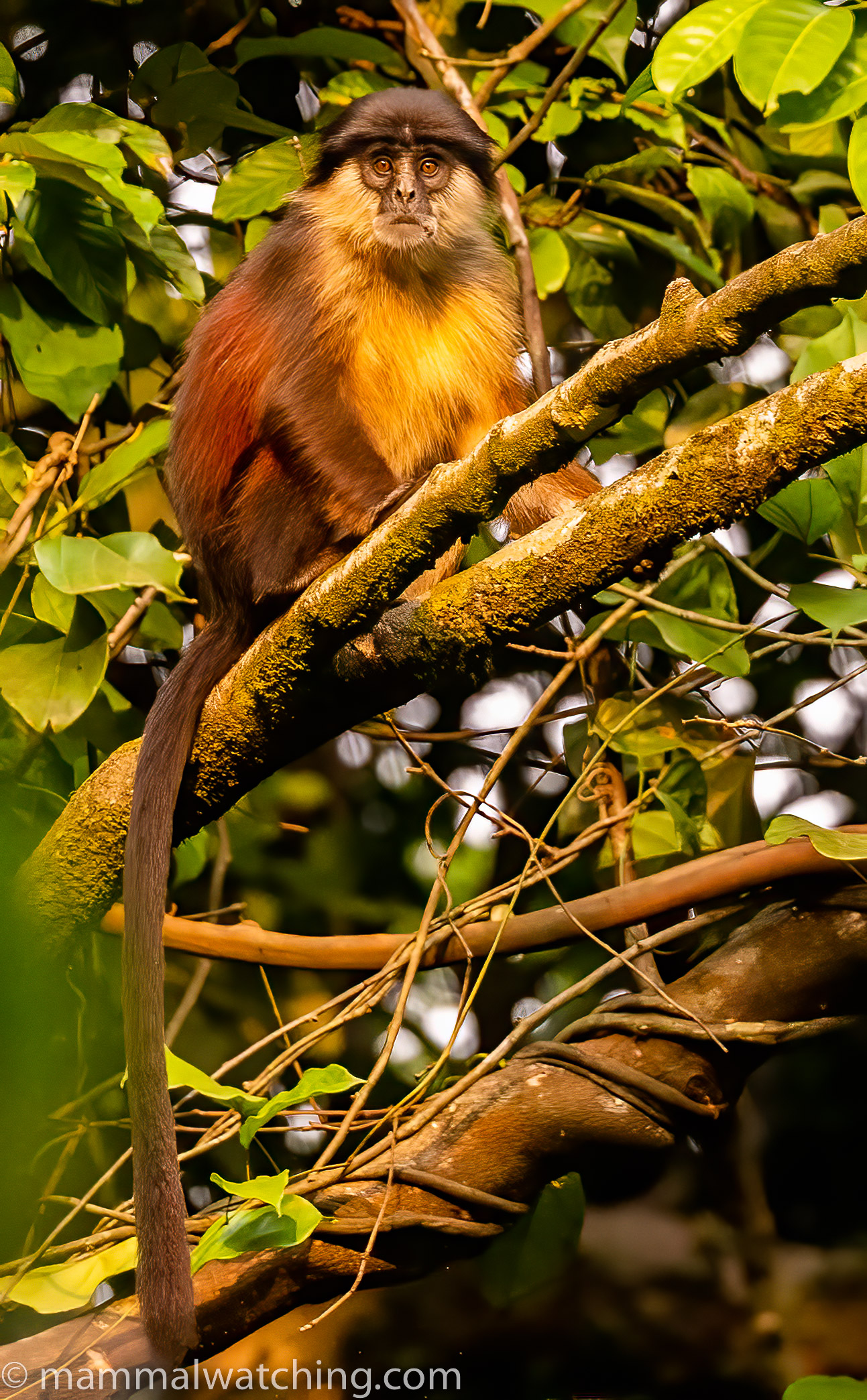
Bioko Island, January 2023
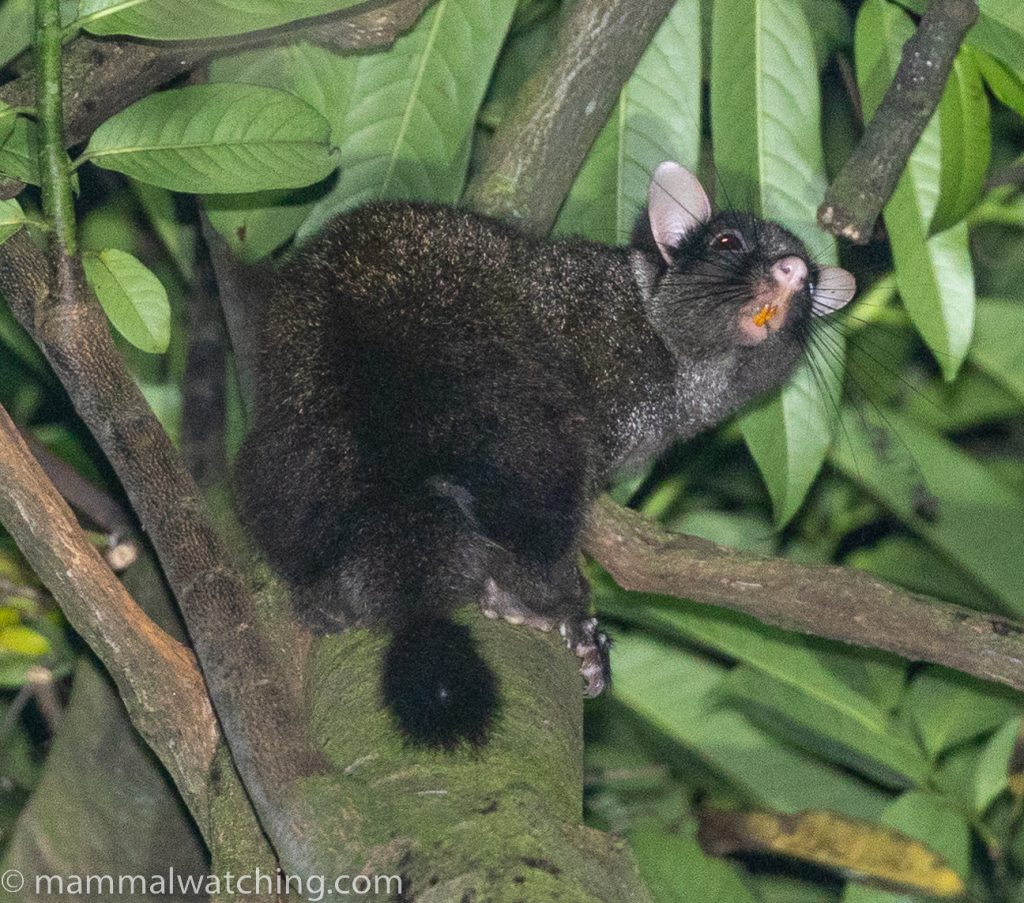
Bioko Island, a part of Equatorial Guinea, has been a bucket list trip since I read a trip report from Bob Berghaier in 2010.This was an African Eden, filled with exotic beasts and few people. I had no idea how to visit. Five years later Curtis Hart sent one, and then another, fantastic report after spending months working on the island during the winters of 2014/15 and 2016/17: Pangolins, African Linsang, Cameroon Scalytail and a bunch of endemic primates. It climbed higher up my bucket list. But after 5 minutes on Google it was clear that tourist visas were pretty much impossible to get. And I needed a visa.
Fast forward to 2019 and Guillermo Casanovas, who’s travel agency – Middle Africa – organized my trip to Gabon, got in touch. Guillermo had just arranged a mammalwatching trip for Justin Brown to Bioko. Thanks to his reputation in Equatorial Guinea and his very many contacts, he was having some success in arranging tourist visas.
We planed a trip for January 2021 and I found others to come along. COVID scuppered those plans, and also our plans for January 2022. But in January 2023 we got there.
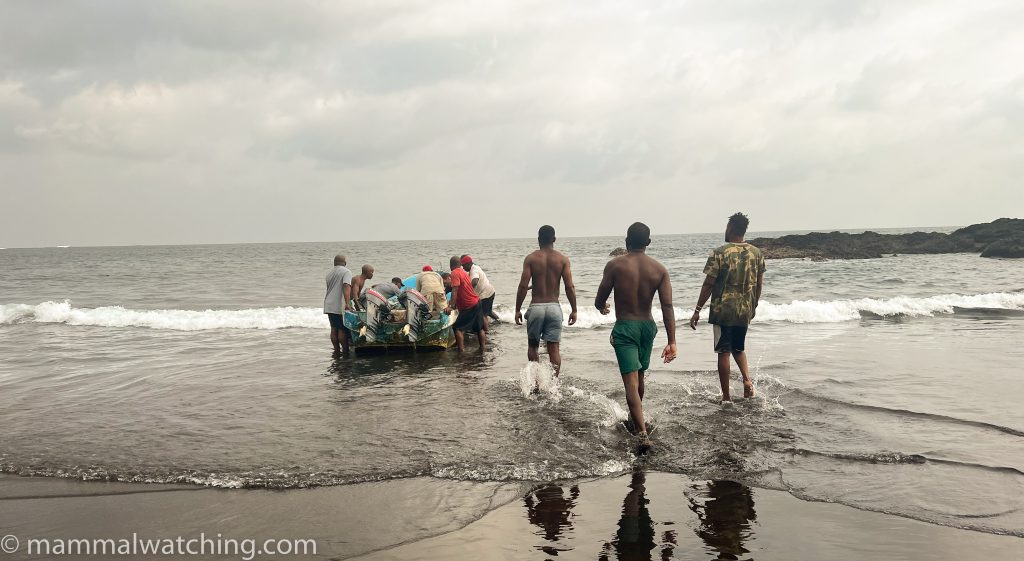
GETTING THERE AND AROUND
Most nationalities – but not US citizens – need a visa to visit Equatorial Guinea. And visas have traditionally been very hard to get (see https://en.wikivoyage.org/wiki/Equatorial_Guinea which also has some interesting background on the economy and government). There is a reason this is one of the least visited countries on the planet.
But Guillermo has helped a few intrepid tourists get visas over the past few years. The process is still not easy: I had to ask the FBI to give me a Guaranteed Crime Free certificate for starters. And despite applying months in advance I very nearly did not get my visa. After a catalogue of problems that ranged from the speed of EG bureaucracy to the incompetence of DHL, my passport arrived in France less than 24 hours before my flight departed. Yes, I was stressed.
After that it was easy. I flew via Paris on Air France’s daily flight to Malabo on Bioko Island. The plane stops in Douala, Cameroon at which point 95% of the passengers get off. From there it is a 15 minute hop to Equatorial Guinea.
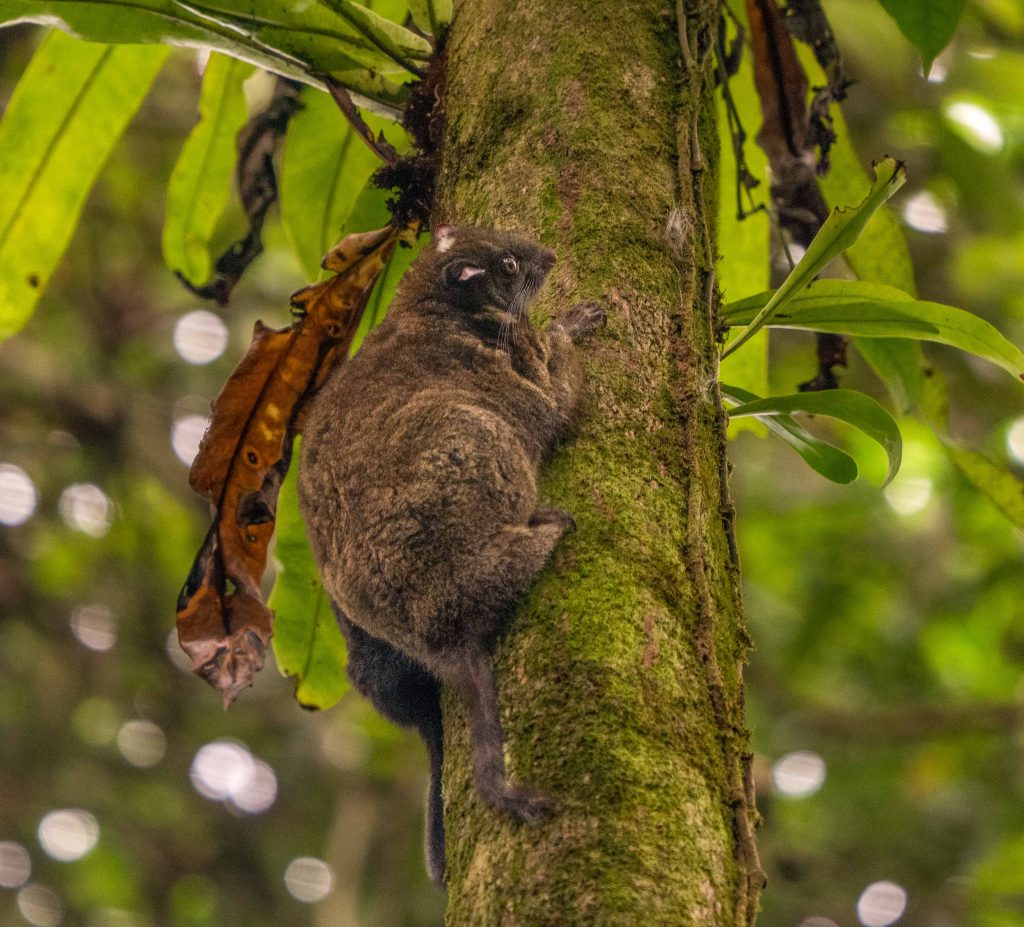
The complications with my visa left me paranoid that I wouldn’t be allowed onto the plane or into the country. But entry was straightforward. Customs checked all our bags carefully when we arrived, but my thermal scope went unnoticed. They checked my bags even more carefully when I left. And five different people checked my ticket and passport on departure. If they ever decide they want a tourist industry then I suggest Equatorial Guinea: hard to visit, harder to leave as a slogan.
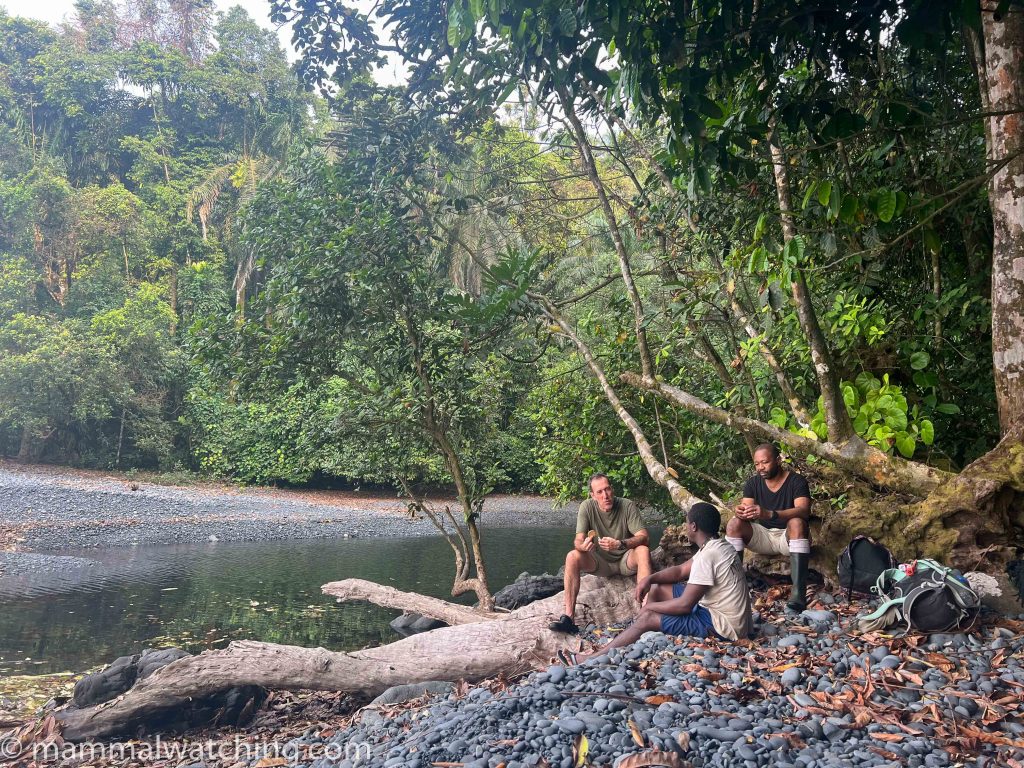
ITINERARY
This was a short trip. Just a week. We decided to visit three areas, largely based on the detailed advice in Curtis’s report:
Moraka in the Reserva Científica de la Caldera de San Carlos where we would spend 4 nights;
Moka in the highlands where we would spend 2 nights; and
Pico Basilé National Park, near Malabo, for a morning or two.
We considered also visiting Moaba Camp and the Caldera itself in the Reserva Cientifica but decided, based on Curtis’s advice, that the mammalwatching would be more productive elsewhere.
December and January, the dry season, seem to be the best time to visit.
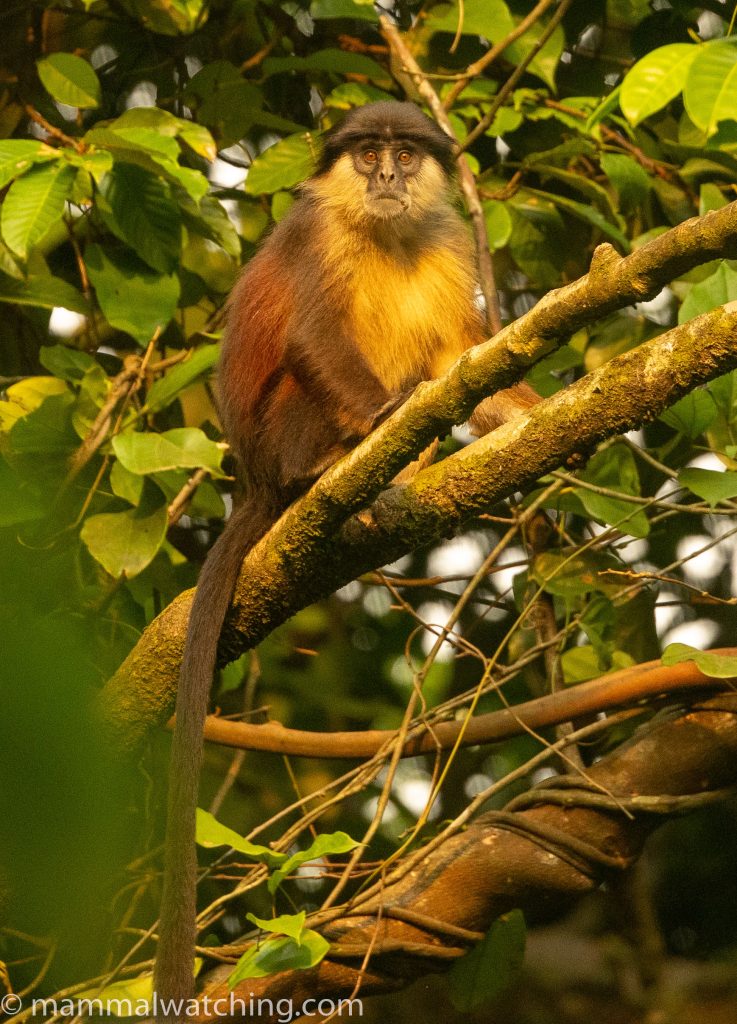
Beyond the now quite dated advice in Curtis and Justin Brown’s reports I could find very little information on what to expect from the mammalwatching. Few – if any – naturalists appear to have visited Bioko since the pandemic began and there were stories of a marked increase in bushmeat passing through the Malabo market since COVID. None of us – including Guillermo – knew what to expect.
Guillermo’s team organized everything. Trying to navigate the island on your own would be difficult. First, it is expensive. Second, we needes a special permit to do anything or go anywhere. Some had to be applied for well in advance. While permits to travel to the southern beaches were obtained en route. We were told to sit in a restaurant and keep a low profile until the permits were issued. This worked. But I am pretty sure it wouldn’t have if I had been doing the asking.
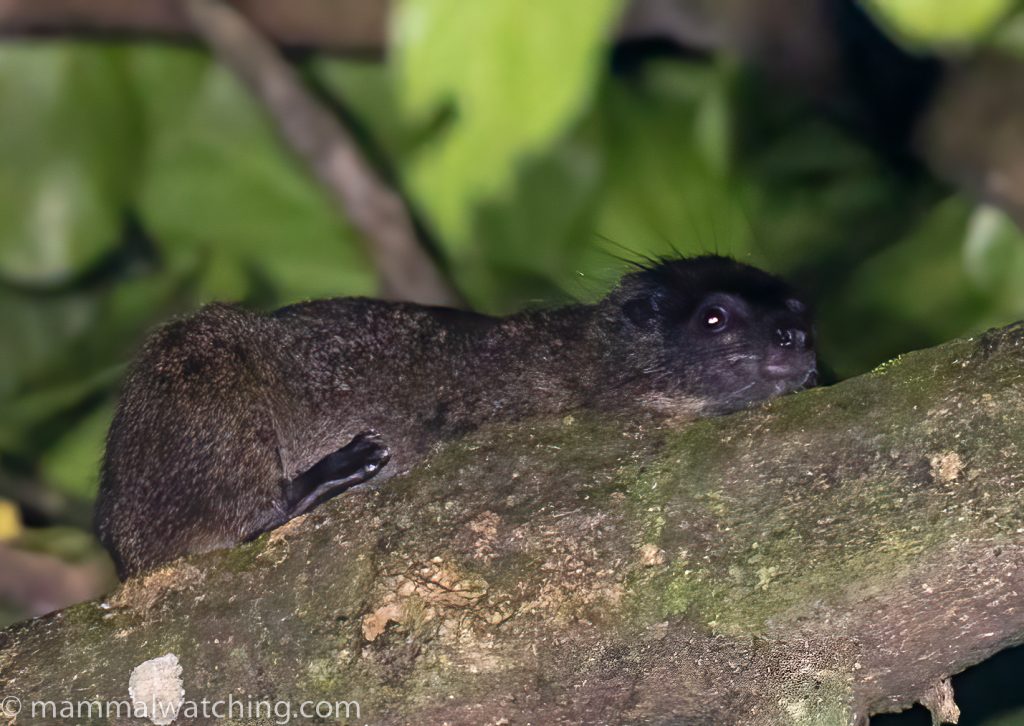
I landed in France from New York the day before my Paris to Malabo flight. I arrived at the same time as DHL delivered my Equatorial Guinea visa to my daughter’s place in Paris (I was travelling on a different passport).
My luggage had not left New York. So I dragged long-suffering Katy around at least 10 camping stores in central Paris demanding she did all the talking as I searched for a tent and jungle clothes among a sea of thermal underwear and snowboards.
At 10am the next morning I was boarding the plane, saying hello again to Martin Royle and Kevin Bryan and meeting Mark Cowan for the first time. Twelve hours later we were in Malabo’s Hotel China Anda, with the rest of the team: Cheryl Antonucci, Deb Bradley, Angiolo Laviziano and Nancy Black, as well as our guide, Jorge Fernandez Garces, a Spaniard who works for Middle-Africa.
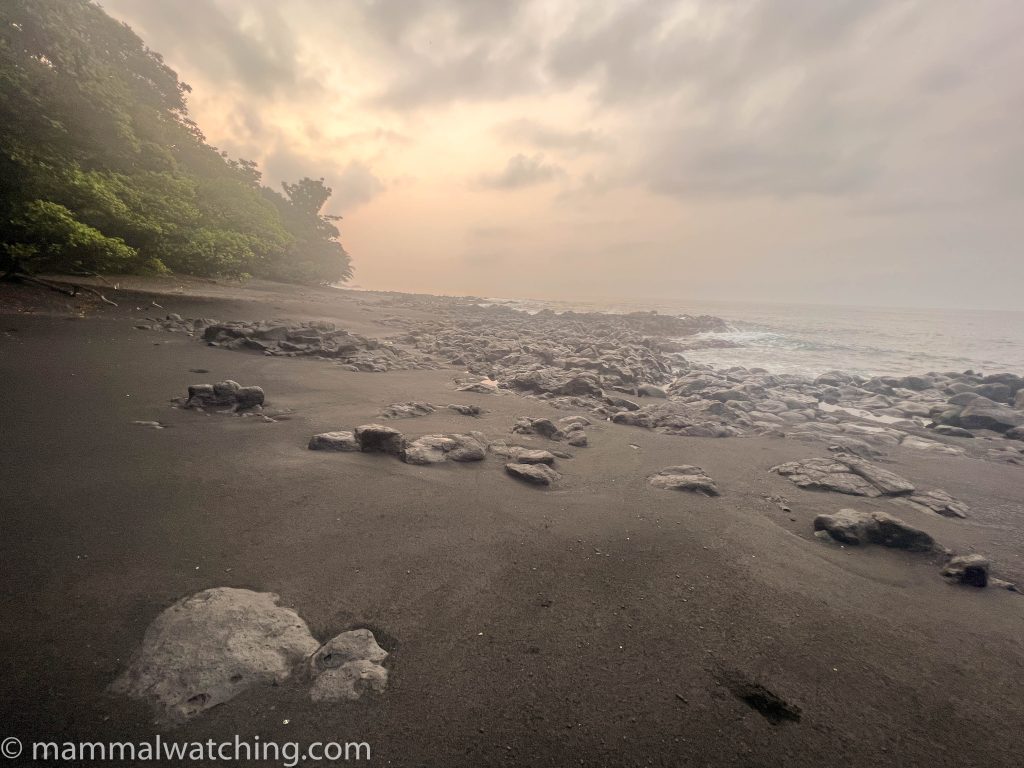
Moraka and the Southern Beaches
To get to Moraka you must drive to the end of the road and then walk for several hours or take a boat from Luba. We took a boat. Middle Africa sent people ahead to set up most of the camp. So after 4-5 hours in a boat we had only to stroll across the beach and erect our tents before it got dark. And it got dark as soon as Martin’s tent blocked out the sky. This is a tent that would require planning permission in most cities.
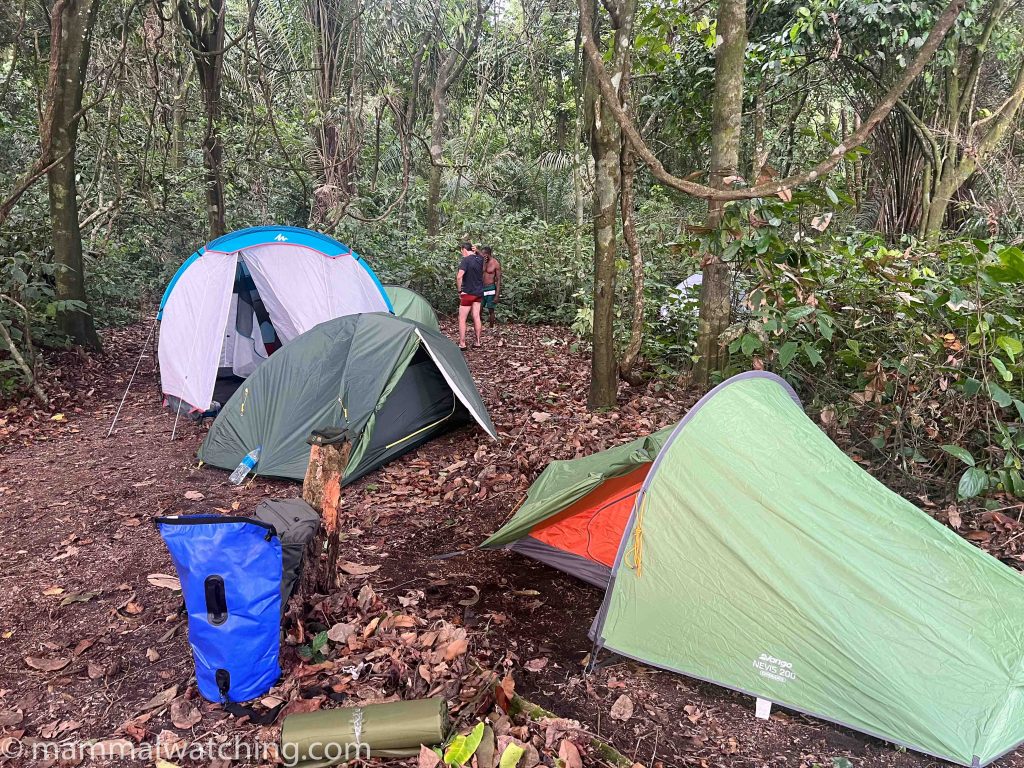
The cooks prepared the first of many tasty meals that evening, after which we took a slow, thermally-assisted, night walk along a forest trail for a few hundred metres to the neighbouring campsite run by the Bioko Biodiversity Protection Program. Curtis had spent his time on Bioko volunteering with the BBPP and had lived here for several months.
We walked that same trail all four nights, largely because the other trails were difficult to navigate in the daytime let alone the dark.
We knew it was going to be hard to see diurnal mammals if we walked in a group of 8. On our first day we split into two groups of 4 and, with the help of our two local guides, took different forest trails. At lunch we knew it was going to be hard to see things in a group of 4! We had heard several primates that morning but getting more than a glimpse of flying fur was challenging even for whoever was at the front of the line. Spent shotgun shells – even next to the BBPP camp – were a clue as to why the monkeys were skittish. But viewing was complicated by the narrowness, steepness and slipperiness of the trails. It was difficult to move quietly and difficult to move and observe at the same time.
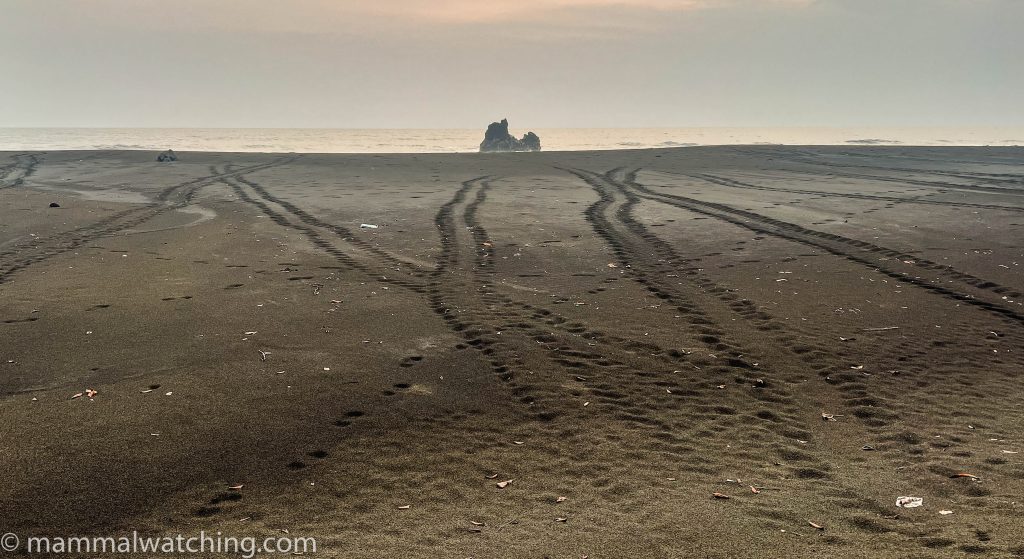
Spirits were low at dinner after our first full day. We were not optimistic about walking the trails and we needed a different plan. The next morning we again split in half. One group staked out a fruiting tree near camp where a BBPP guy had seen a Drill the day we arrived. The rest of us would walk along the beach where Drill’s had been spotted digging up turtle eggs from the many nests.
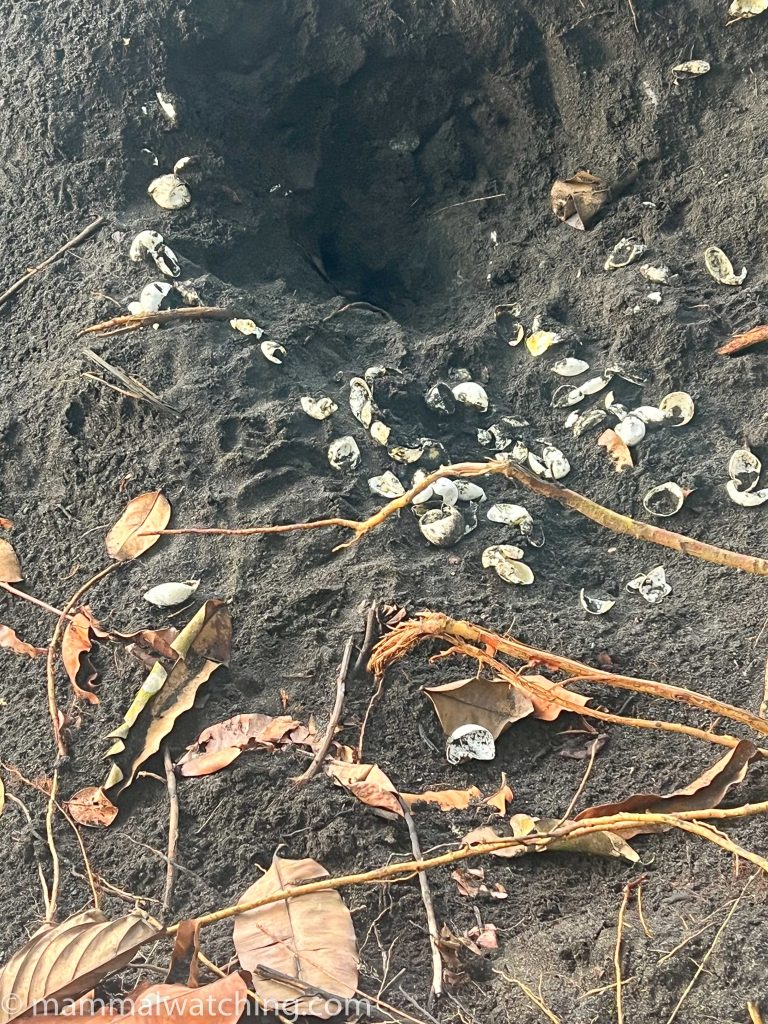
The rhythm of initial optimism turning to pessimism is a familiar beat on a mammal trip. I was not (yet) all that concerned though it was indeed frustrating that we had heard Drills but not come close to seeing them. We still – as Guillermo had kept telling me about my visa – had time!
Our second morning was more successful. Fresh Drill tracks criss-crossed the beach. Some of those walking the beach saw a Drill briefly (though not me even though I was near the front of the line). And our guide rearranged some of the excavated turtle eggs and, an hour later, as we walked back down the beach, the eggs had been moved. There were plenty of animals around. We had to figure out how to see them.
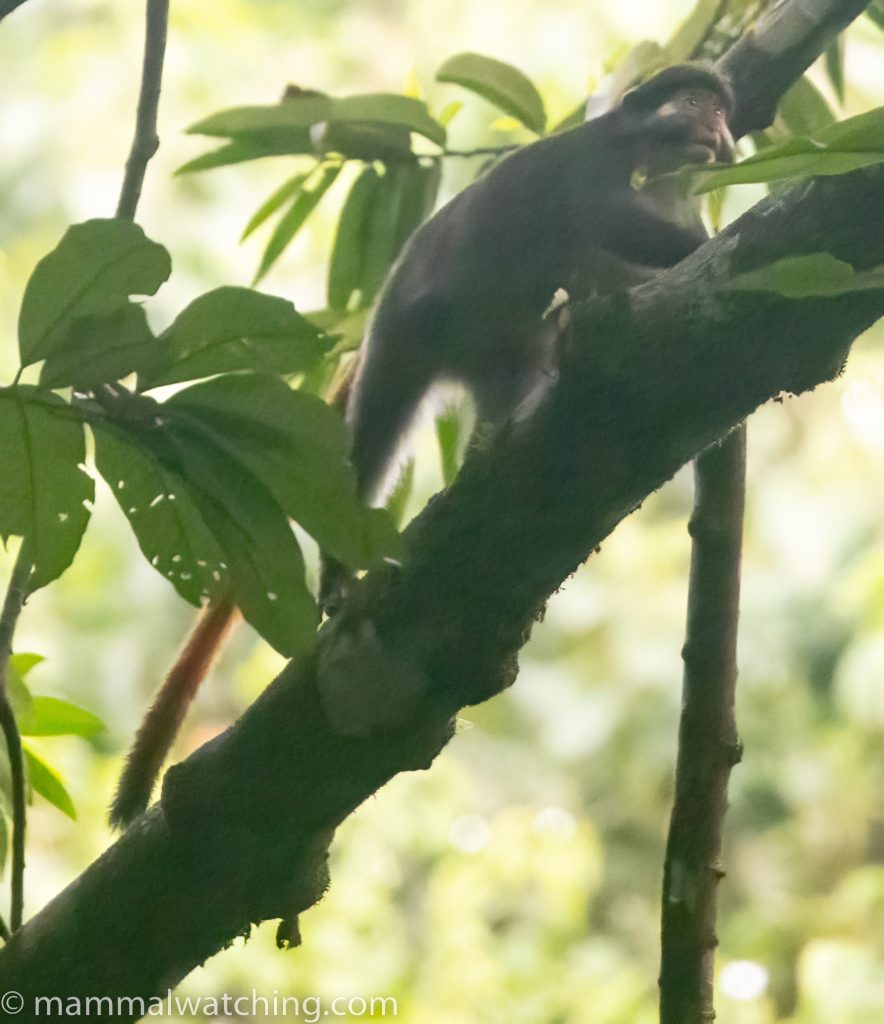
Back at camp the other group had struck out after three hours in front of the fruiting tree. We considered our options. Cheryl and Deb were the first to break ranks. They decided to sit quietly on a dry river bed just a hundred metres from camp. A triumphant Cheryl returned 90 minutes later. She had seen a Drill. But Deb, 20 metres from her, had not. An hour later Deb was back and smiling. She had seen an animal in a tree close to the BBPP camp.
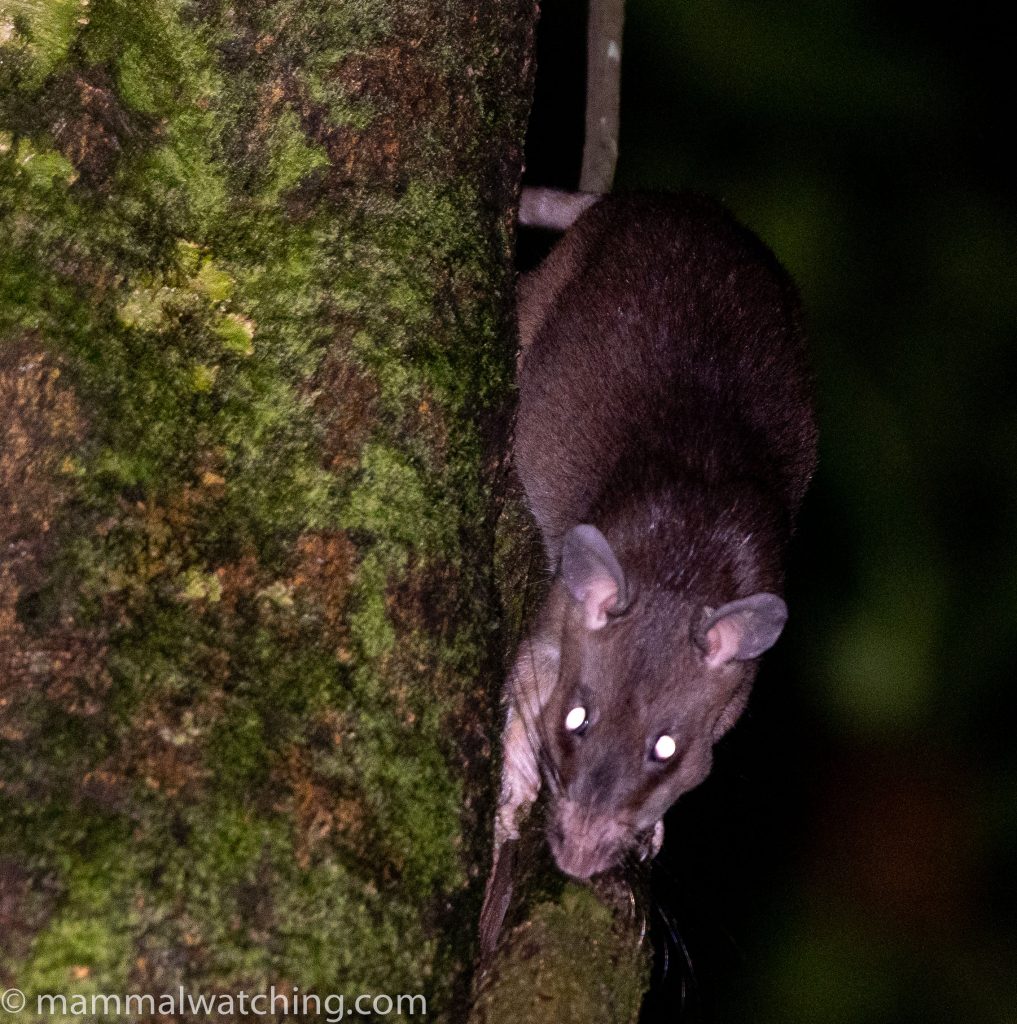
At that point all thoughts of group solidarity flew out the window. Everyone split up to do their own thing as the Drills seemed much easier to see on your own. Jorge did not want anyone walking the main trails alone, but so long as we stayed on the path between the two campsites, or on the beach, he could tolerate the anarchy. By the end of that second afternoon we had all seen a Drill other than Martin. And he had a good view the following morning before breakfast.
We spent the third – our last – full day doing our own things. Some of us wandered back and forth between the two campsites and spent hours sitting on the bank of the dry river bed near camp. Others walked up the beach. Only Angiolo had crippling views of Drills: he had a prolonged view of a group on the edge of a river half an hour up the beach and he got video. But we all had enjoyable mammal encounters that last day. My highlights were an Ogilby’s Duiker and – finally – a good look at a Red Colobus in the late afternoon. But I will talk about the mammals later.
I was bitten by very few bugs here, or anywhere on the island. Not everyone was so lucky. And one of our group went down with Malaria when she got home. So in hindsight I should probably have taken my malaria prophylactics after all.
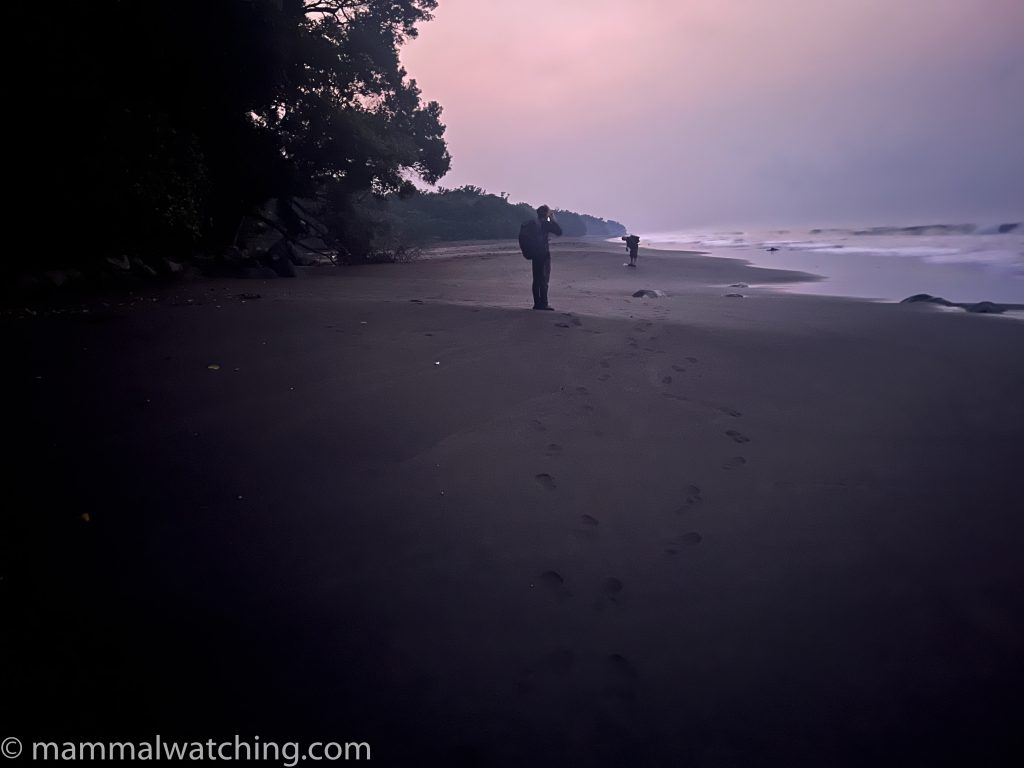
It was a long walk back to the road on our final day. It would have been longer if an army of porters had not carried everything. The route would be difficult at high tide – as much of the beach disappears – and so we left at 4am to beat the water. Strolling along the moonlit beach was a favourite moment of the trip. It took about 6 hours to get back to the road, but we took it slow and rested. About two-thirds of the walk was on the sand, with an hour or two of forest trail.
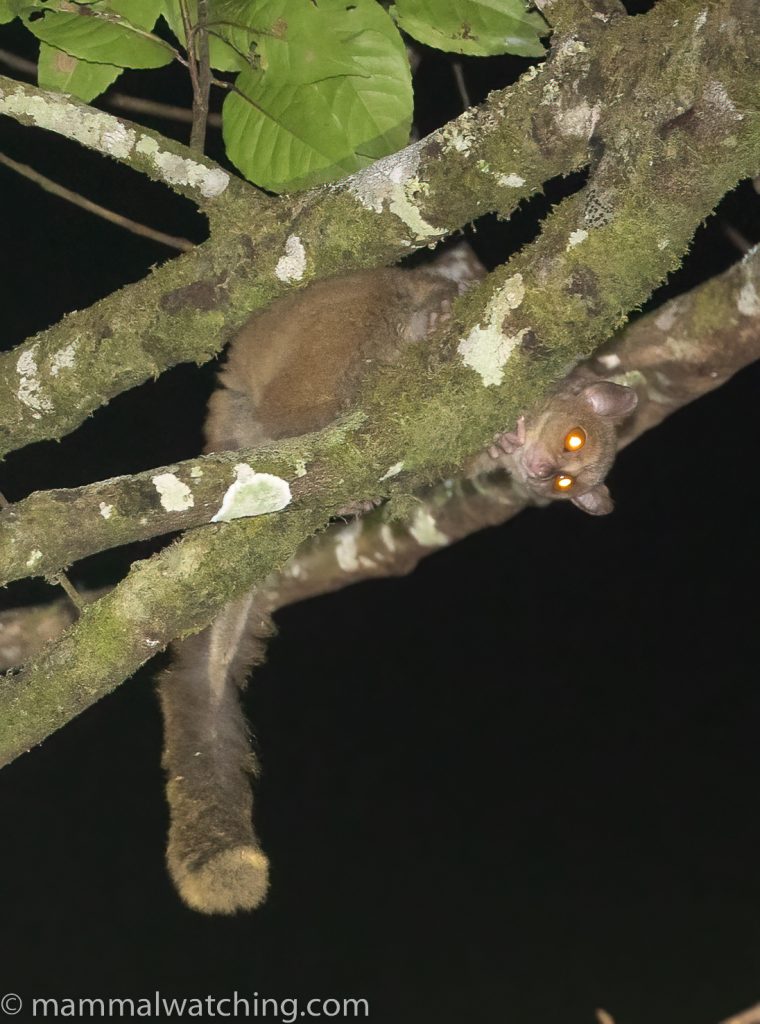
Moka
It took about 2 hours to drive to Moka from the Moraka trailhead near Eureka. We stayed in a comfortable hotel for two nights. Curtis Hart had seen three species of galagos here and wrote that the nature trail was “great” for galagos and other species including African Linsang.
We didn’t have as much luck. We took a night walk here both nights with our excellent BBPP guide Djibril. During several hours of spotlighting we saw only 4 Northern Needle-clawed Galagos and a mystery rat (possibly something like Grammomys poensis).
There was not much mammalian to look for in the day time, so we spent a morning wandering through scrubby forest and cow pasture. The most interesting encounters were with a Sun Squirrel and two soldiers carrying guns who seemed to be hunting not soldiering. Back in the village we were shown Angolan Soft-furred Fruit Bats. Moka village had a pedestrian crosswalk every 10 metres. But there were no pedestrians and no traffic. I still find this amusing.
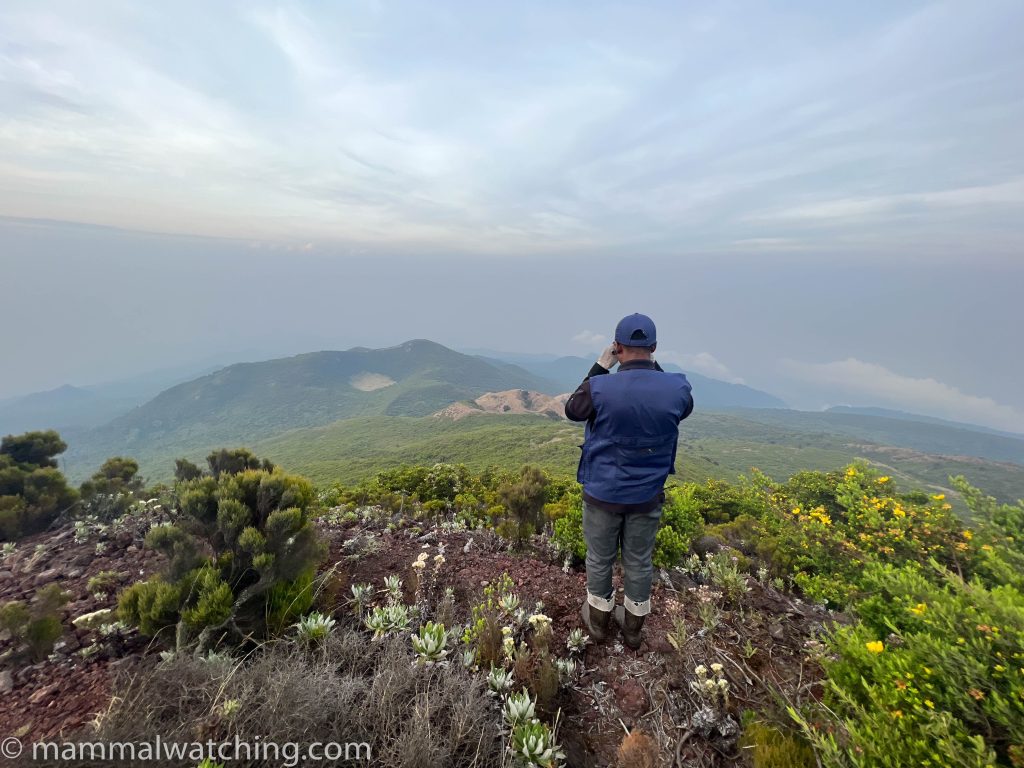
Pico BasilÉ National Park
Pico Basilé National Park is two hour’s drive from Moka and an hour or so from Malabo. The 3,000m mountain has lovely mossy forest and a military base near the summit. The park is, we were told, strictly controlled. We needed to apply for visitor permits several days ahead of time and were warned about taking pictures of the military base. Controls seem less strict for those who turn up with a shotgun rather than a camera. We saw people walking along the main road through the park with guns over their shoulders. One of them had a duiker in his backpack. And we heard more gun shots than primates.
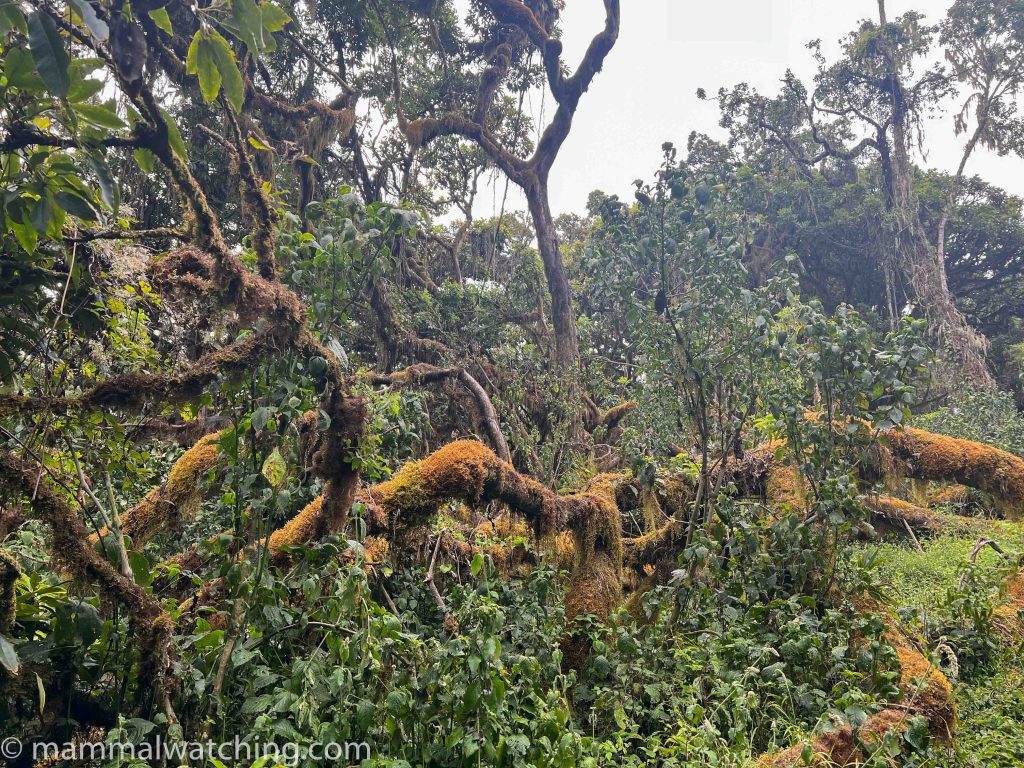
The rare Preuss’s Monkey is the main reason to visit the park. Curtis’s report suggested they were going to be hard to see: they sounded considerably more skittish than the primates at Moraka. Sure enough, none of us got close to seeing a Preuss’s while walking the park trails. But Martin Royle tried a different approach. Even though the guides seemed sure the trails were the better monkeywatching option he wanted to walk along the road because it offered a much better view of the forest.
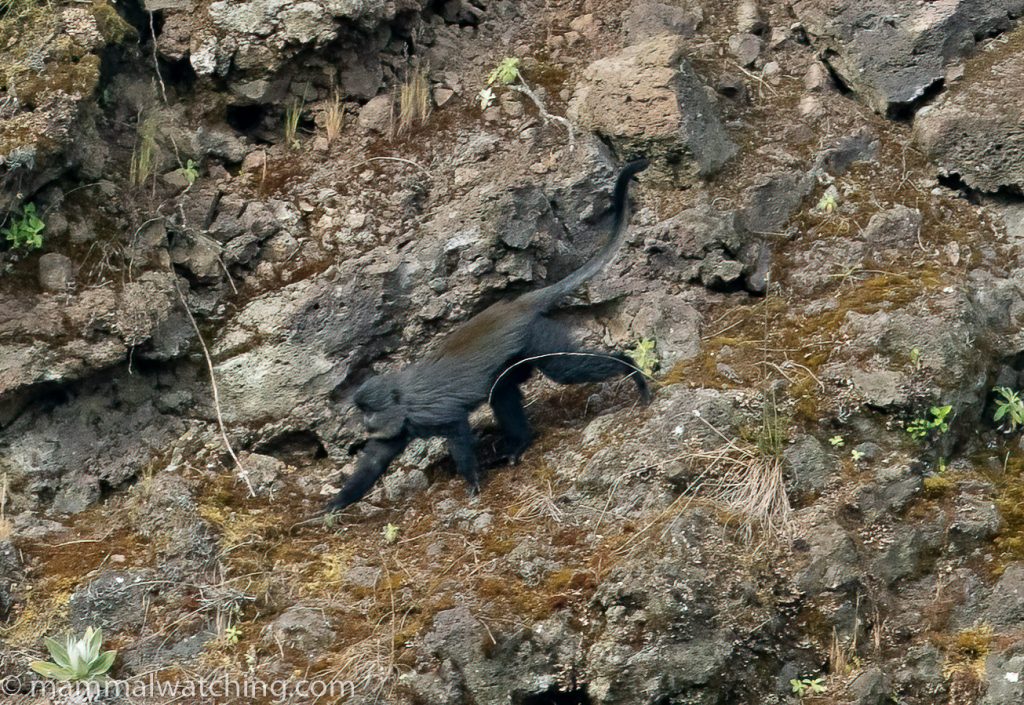
In 45 minutes saw several Preuss’s Monkey. Thankfully I had already arranged a permit to return to the park the following day because I had expected this species would be tricky. I was back the following dawn and stuck to the road. I saw multiple Preuss’s Monkeys.
The Mammals
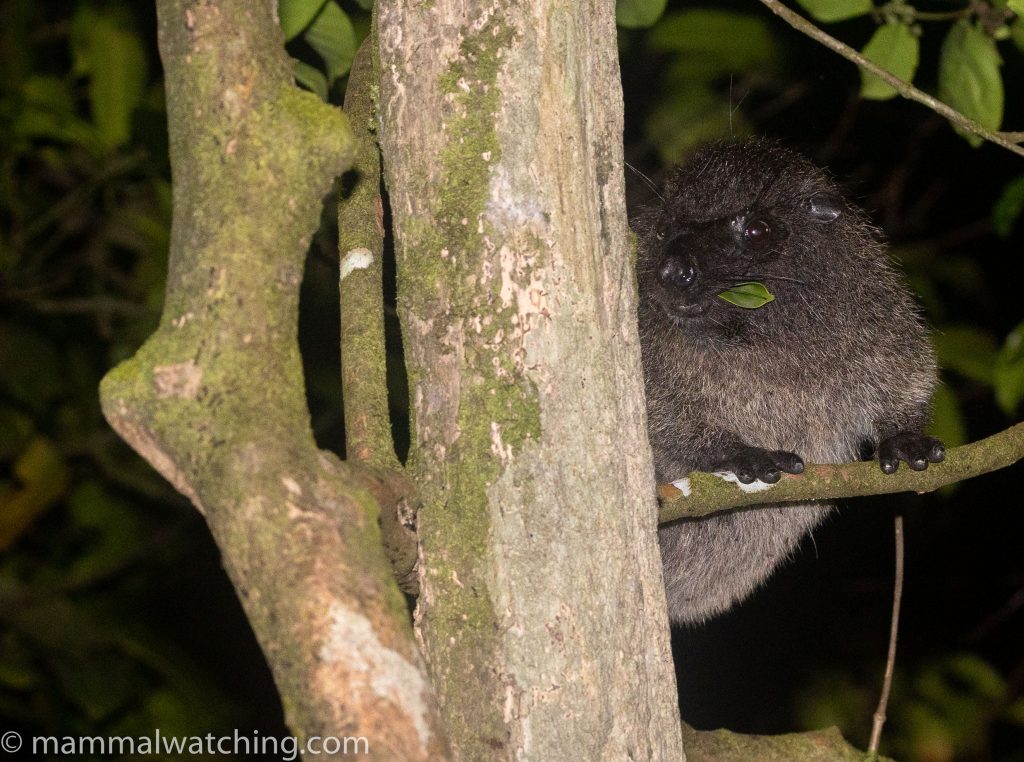
Western Tree Hyrax (Dendrohyrax dorsalis)
Tree Hyraxes were common around Moraka camp. They called through the night, and could often be heard during the day, especially when it was overcast. Many were low and in small trees. Much easier to find with a thermal scope than a flashlight (they have almost no eyeshine).
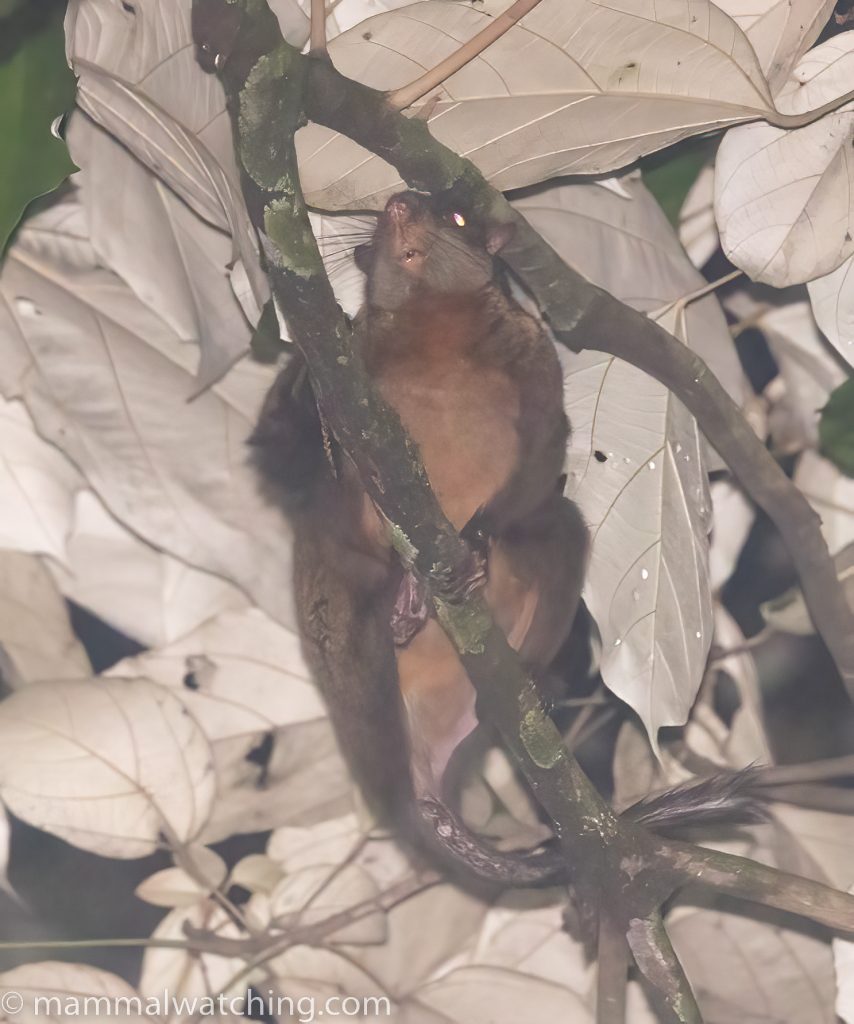
Beecroft’s Flying Squirrel (Anomalurus beecrofti)
Common around Moraka. We saw one or two every night, and there was one roosting on a tree trunk in the middle of the BBPP camp one morning. The thermal scope helps with finding these.
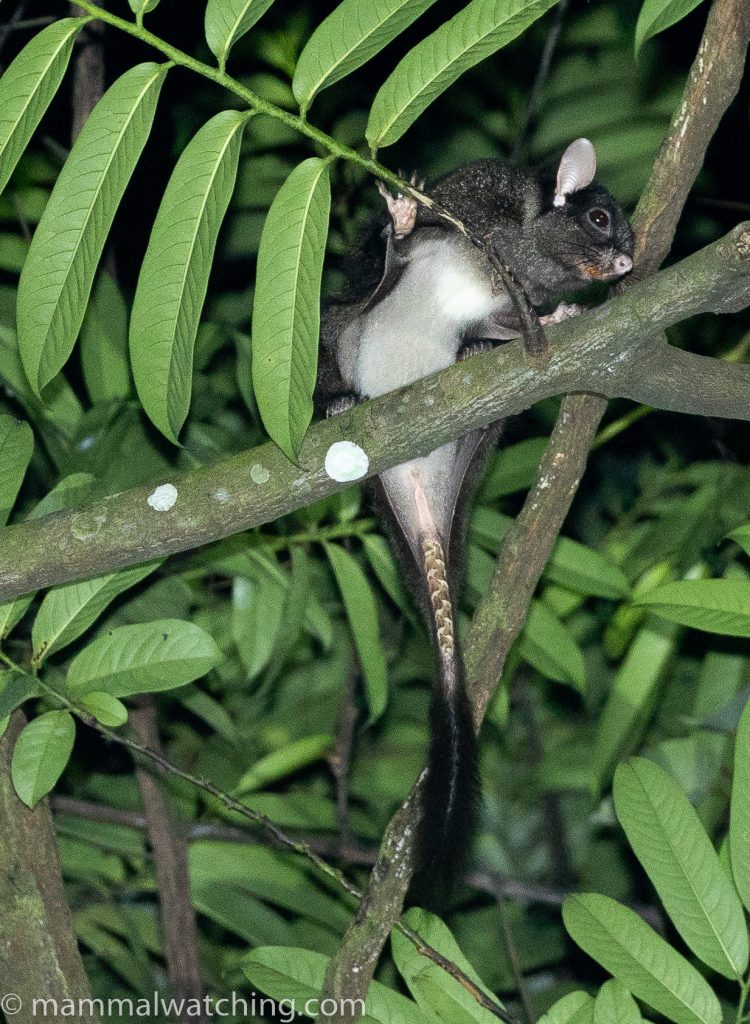
Lord Derby’s Anomalure (Anomalurus derbianus)
We had a great look at one of these on our first night in Moraka and saw another one or two during our stay. The picture shows very clearly why anomalures are also called scaly-tails.
African Pygmy Squirrel (Myosciurus pumilio)
Martin Royle saw an individual near Moraka Camp, on the trunk of a large tree. I tried to find one but couldn’t.
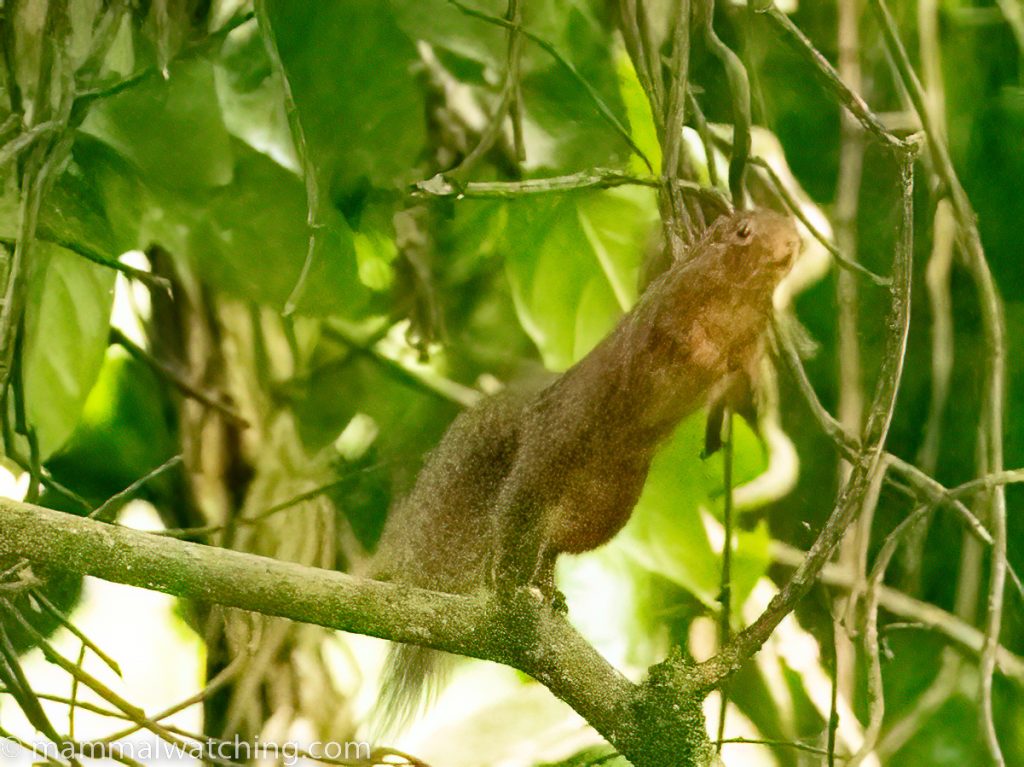
Isabelline Red-legged Sun Squirrel (Heliosciurus rufobrachium)
Red-legged Squirrels were by far the most common squirrel at Moraka and we saw multiple animals each day, though usually moving fast and in poor light. We saw one in a forest patch near Moka.
African Giant Squirrel (Protoxerus stangeri)
Several at Moraka: hard to photograph.
Red-cheeked Rope Squirrel (Funisciurus leucogenys)
scarce at Moraka and far less common than the Red-legged Squirrel. I saw one. So did some of our group.
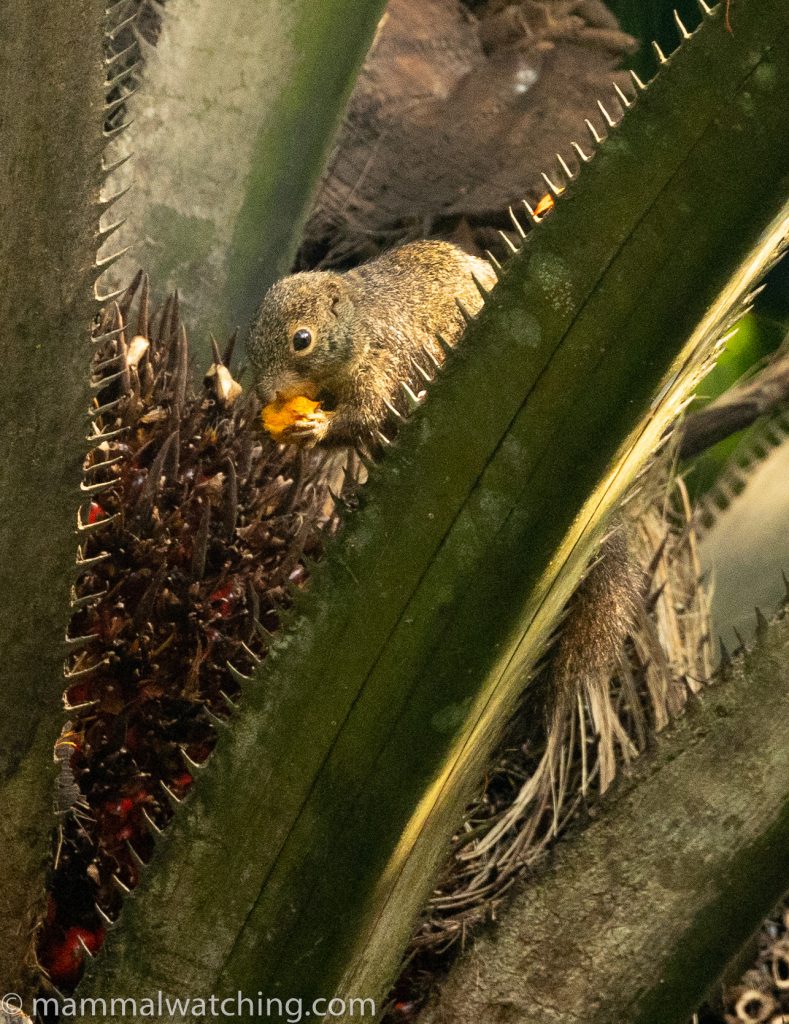
Green Bush Squirrel (Paraxerus poensis)
Two or three around Moraka.
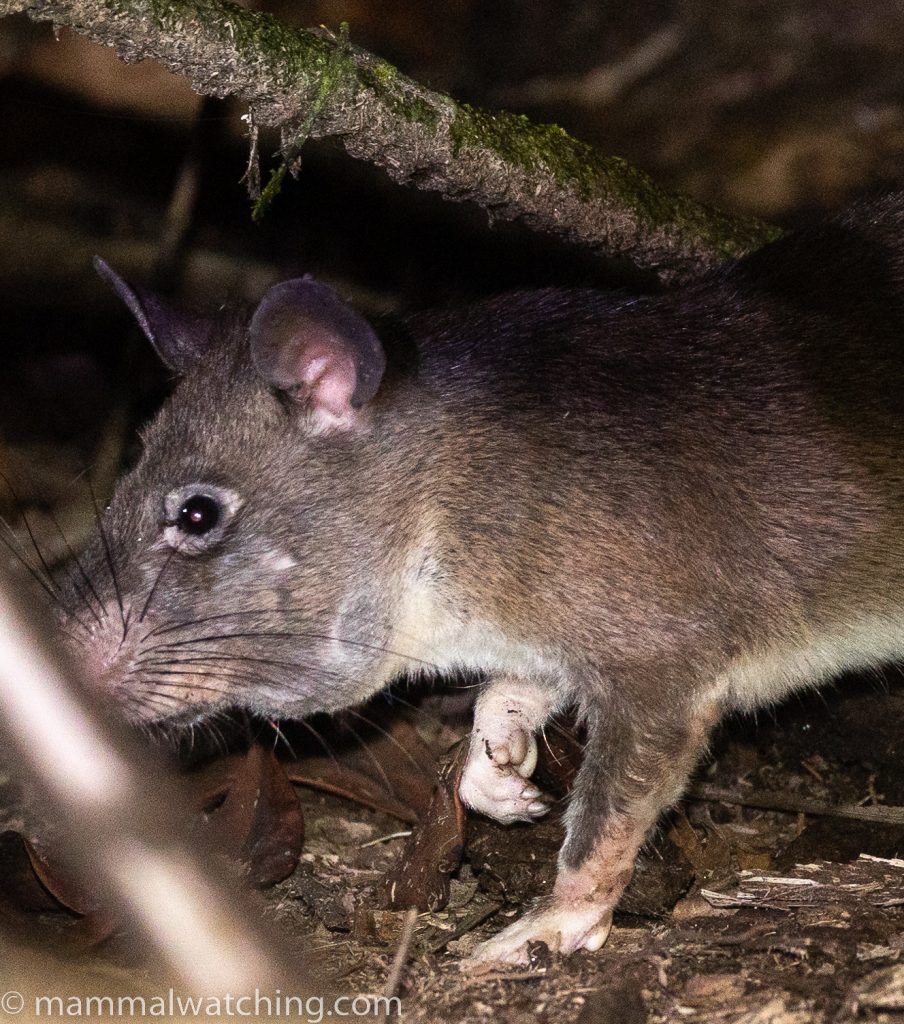
Forest Giant Pouched Rat (Cricetomys emini)
Very common around Moraka Camp. We saw several animals each night, mainly on the ground, between the two campsites or near the BBPP camp kitchen.
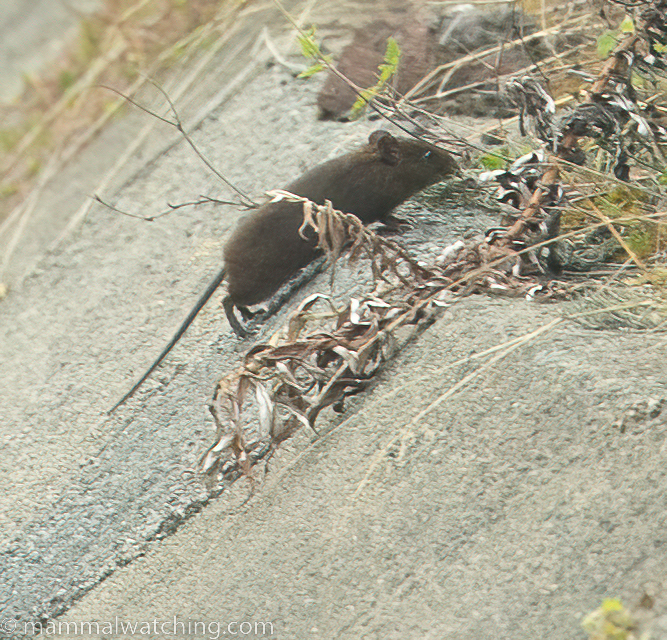
Bioko Hybomys (Hybomys basilii) – endemic
A largish rat was active alongside the road near the Pico Basile summit. There are very few diurnal rodents up here so this was fairly easy to identify (with help from Venkat Sankar and Curtis Hart).
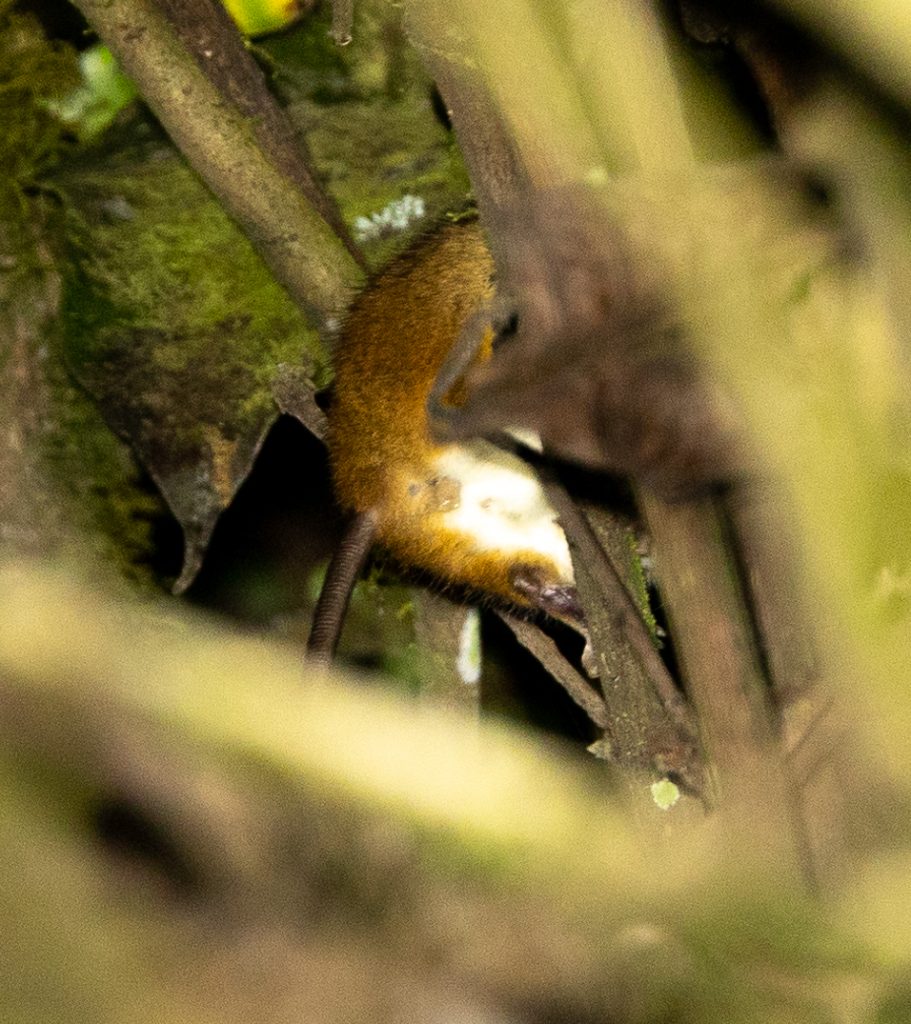
Western Rainforest Thicket Rat (Grammomys poensis) (?)
A shot in the dark with the ID (thank you Venkat for this super-tentative suggestion) but this is the motionless butt of a colourful rodent we spotted while looking for galagos at Moka.
Allen’s Hylomyscus (Hylomyscus alleni)
Cameroon Praomys (Praomys morio)
A smallish mouse, with a shorter tail than the arboreal hylomyscus species, was seen quite well at the BBPP campsite on the ground near the cooking area. It looked like a praomys. I believe only one species is known from Bioko at the moment: Cameroon Praomys. Curtis caught both hylomyscus and praomys mice here but they were never conclusively ID’d.
We saw a handful of long-tailed mice running around in trees near Moraka camp after dark that all looked like hylomyscus species to me, though none was photographed. From what I can tell only one species is known from the lowlands of Bioko: Allen’s Hylomyscus. Curtis caught both hylomyscus and praomys mice here but they were never conclusively ID’d..
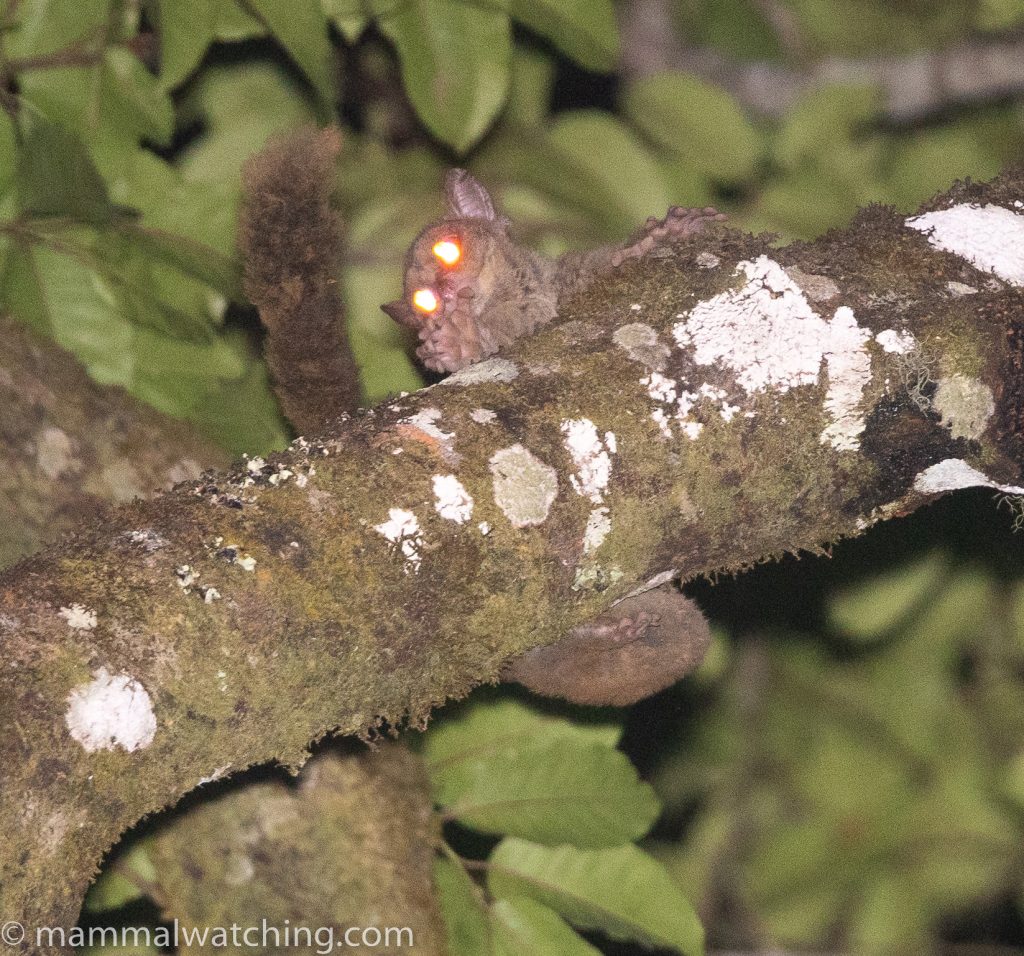
Northern Needle-clawed Galago (Euoticus pallidus)
One animal on the nature trail during our first night at Moka. We saw another two animals on the same trail on our second night, and a third on a steep forest trail that started from the roadside just below the village. I should have taken better pictures. We had hoped also to see Allen’s Squirrel Galago here but couldn’t find any, though our guide thought they were common.
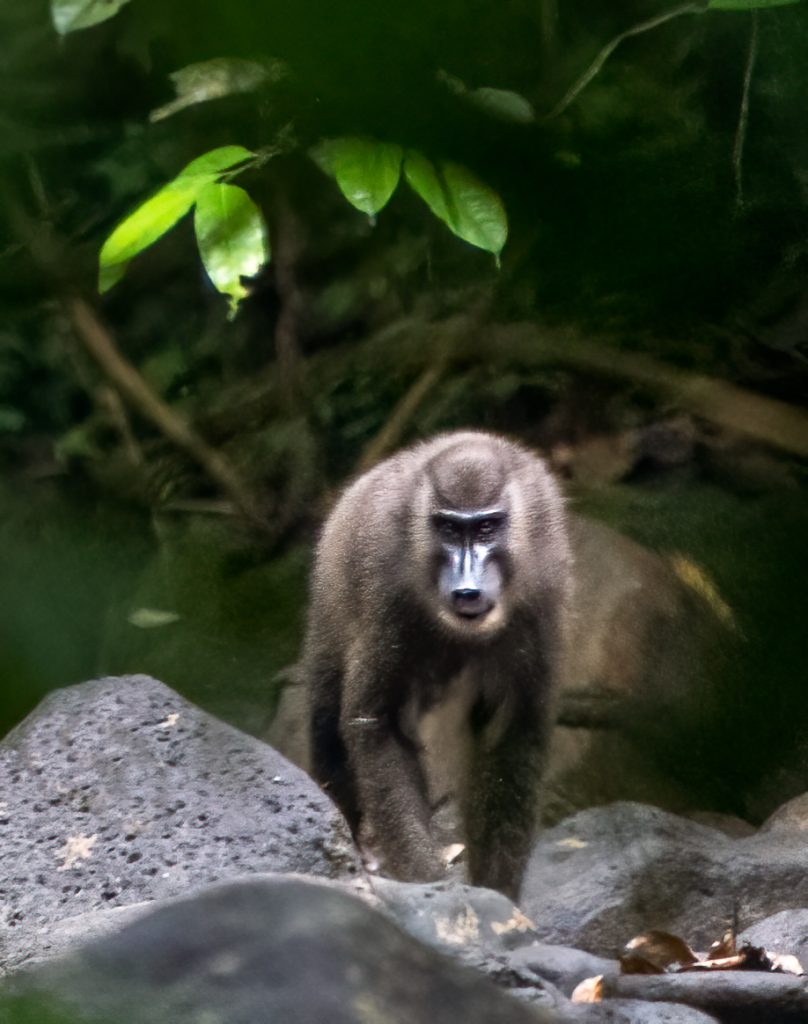
Drill (Mandrillus leucophaeus)
Despite our worries about stories of rampant bushmeat hunting during the pandemic, Drills are still fairly common around Moraka. We saw or heard them every day, which seems consistent with earlier trip reports. They were however wary and extremely difficult to observe for more than a second or two. I saw only one animal for about two seconds at 2pm on our second full day in Moraka. She was walking next to the trail that ran between the two campsites. We saw each other at the same moment and she walked briskly back into the forest while I punched the air in victory. My celebration was a little premature. I feel fairly confident I would have seen more, and seen them better, had I remained focused. By the end of our stay we worked out that the Drill were active along the beach where they were raiding turtle nests. The best views went to those who walked up the beach and staked out spots near freshly raided turtle nests or along a river about half an hour walk up the beach to the west of camp.
But I was complacent, believing I would be bound to see more Drills and so chose instead to focus on getting my lifer Pygmy Squirrel (fail) or seeing the local, beautiful subspecies of Ogilby’s Duiker (success). I didn’t see another Drill. And that was disappointing. I feel like I want to go to a zoo to see this species well.
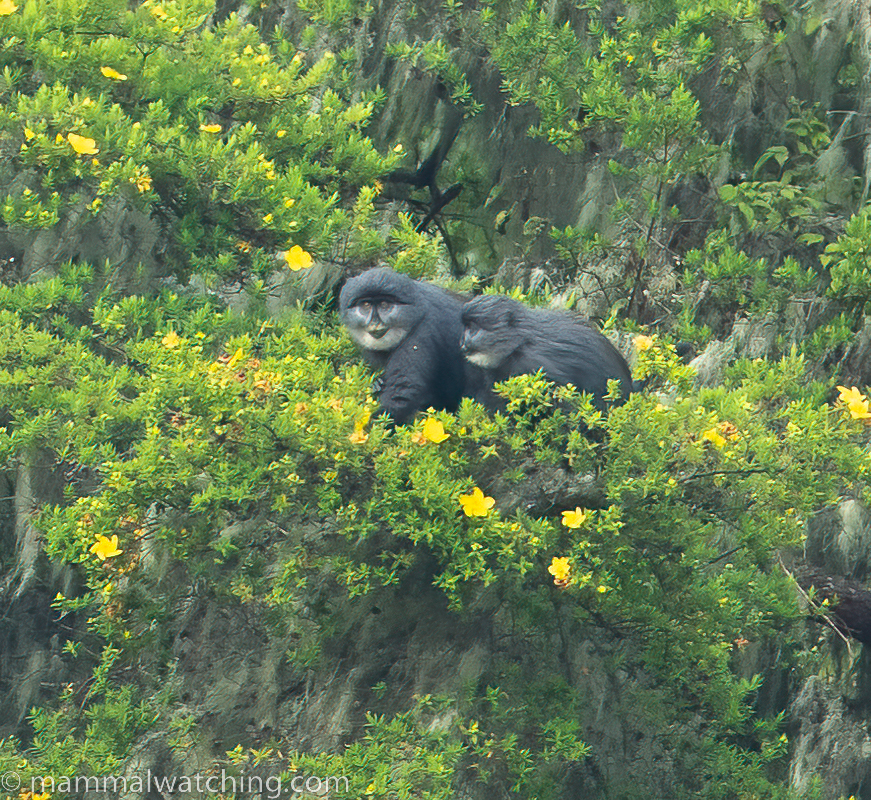
Preuss’s Monkey (Allochrocebus preussi)
I saw groups of animals – in different areas – between 7 and 9 am near the top of Pico Basile. I am pretty sure there were several more groups in my thermal scope though I could not find them in my binoculars. This species seems hard to see from the trails based on our experience in the park. It’s much easier to observe from the upper stretches of the road (the 2km-ish section that runs between the lower trailhead (about here) and the caldera trailhead.
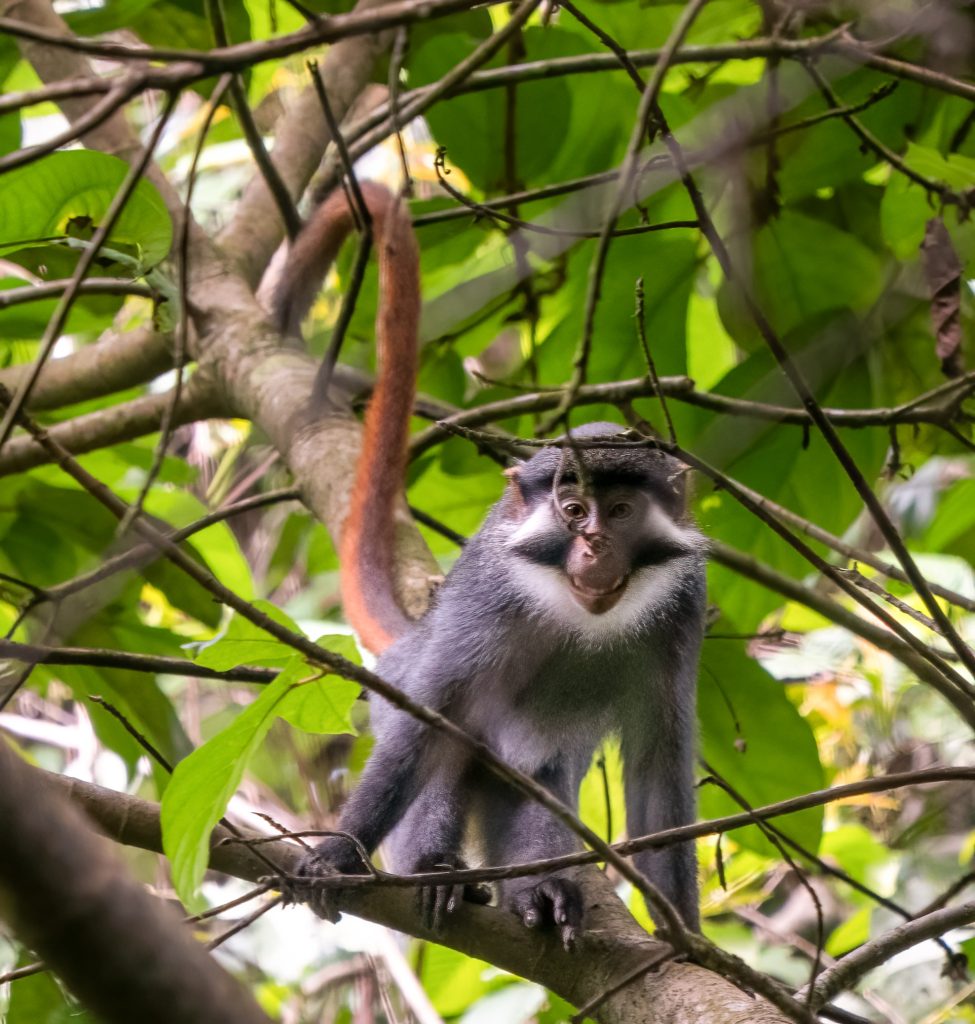
Red-eared Monkey (Cercopithecus erythrotis)
These pretty monkeys were, with Crowned Monkeys, the most commonly seen primate around Moraka. We saw them every day around camp and deeper in the forest. But like the other Bioko primates they were very flighty.
Crowned Monkey (Cercopithecus pogonias)
About as common as the Red-eared Monkeys around Moraka and equally skittish.
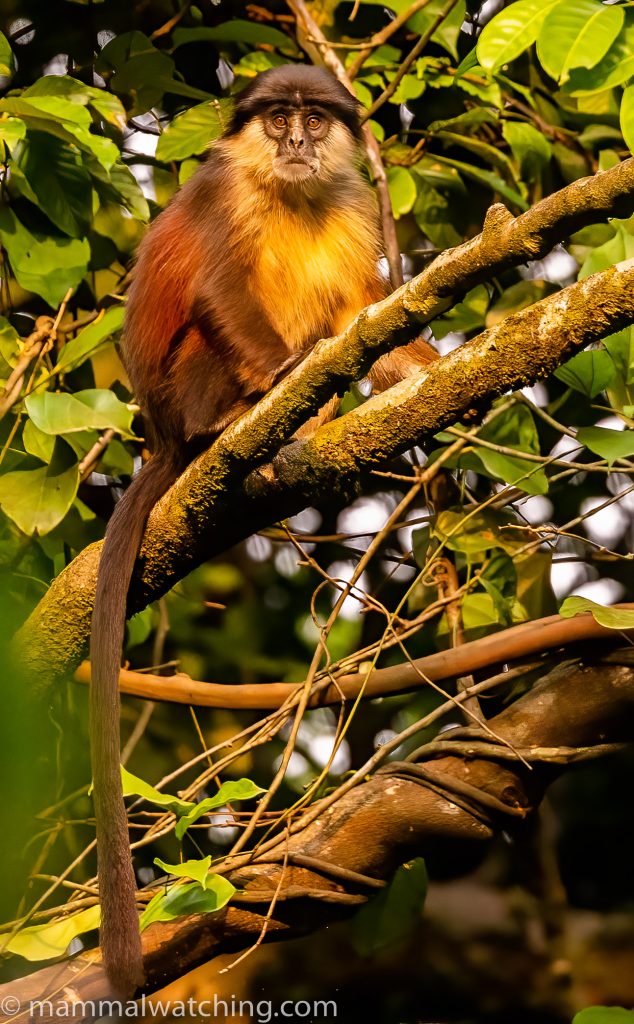
Pennant’s Red Colobus (Piliocolobus pennantii) – endemic
Another key target for the trip, this species was seen most days at Moraka, though not as often as the Crowned or Red-eared Monkeys. My views were generally poor except for this animal that obligingly paused in great light for five seconds close to our campsite during my last afternoon at Moraka.
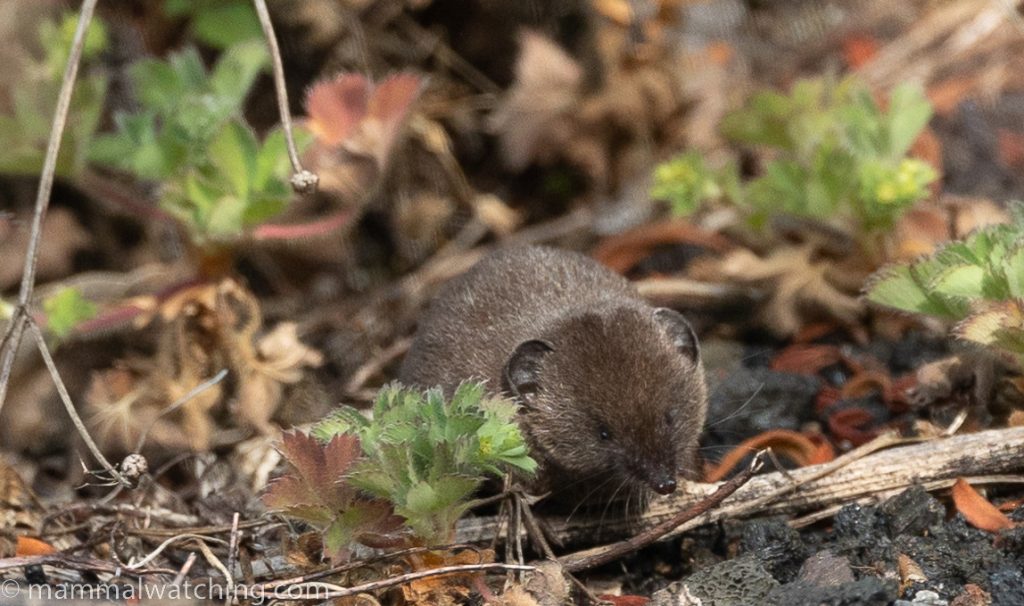
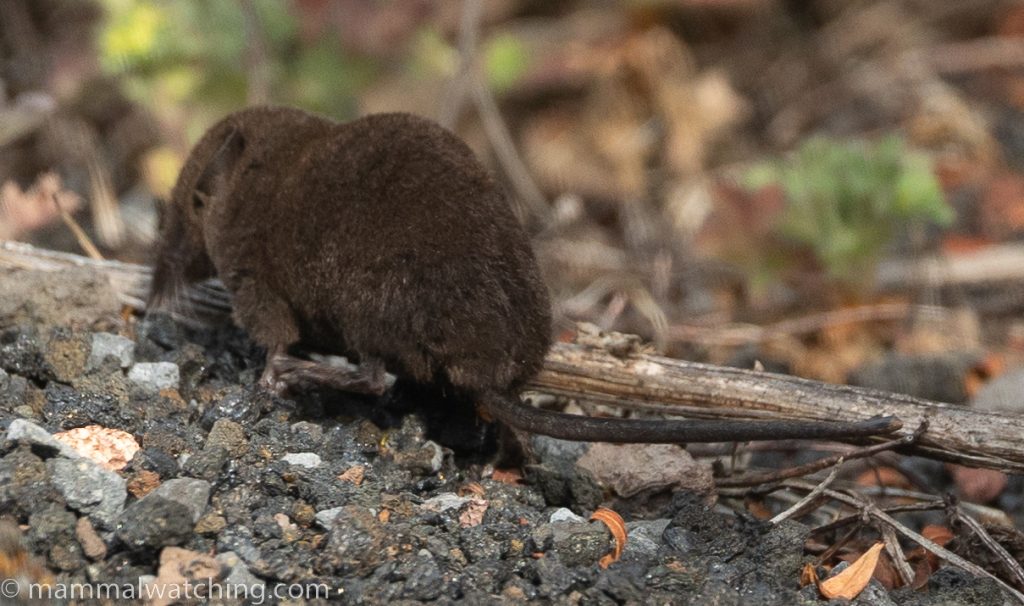
Bioko Forest Shrew (Sylvisorex isabellae)
Bioko has conveniently few small mammals (compared to the mainland) and we saw several shrews up at around 3000m on Pico Basile. This animal was foraging along the edge of the road for several minutes and was quite large (I estimate the head-body length was around 7 or 8 cm). The lack of hairs on the tail rule out most of the options, leaving only the Myosorex or Sylvisorex genera. Myosorex eisentrauti and Sylvisorex isabellae are both found high on Pico Basile.But the ears look wrong (too large and too exposed) for myosorex. So until someone tells me otherwise I am recording this as the Bioko Forest Shrew. Thank you Venkat for the help!
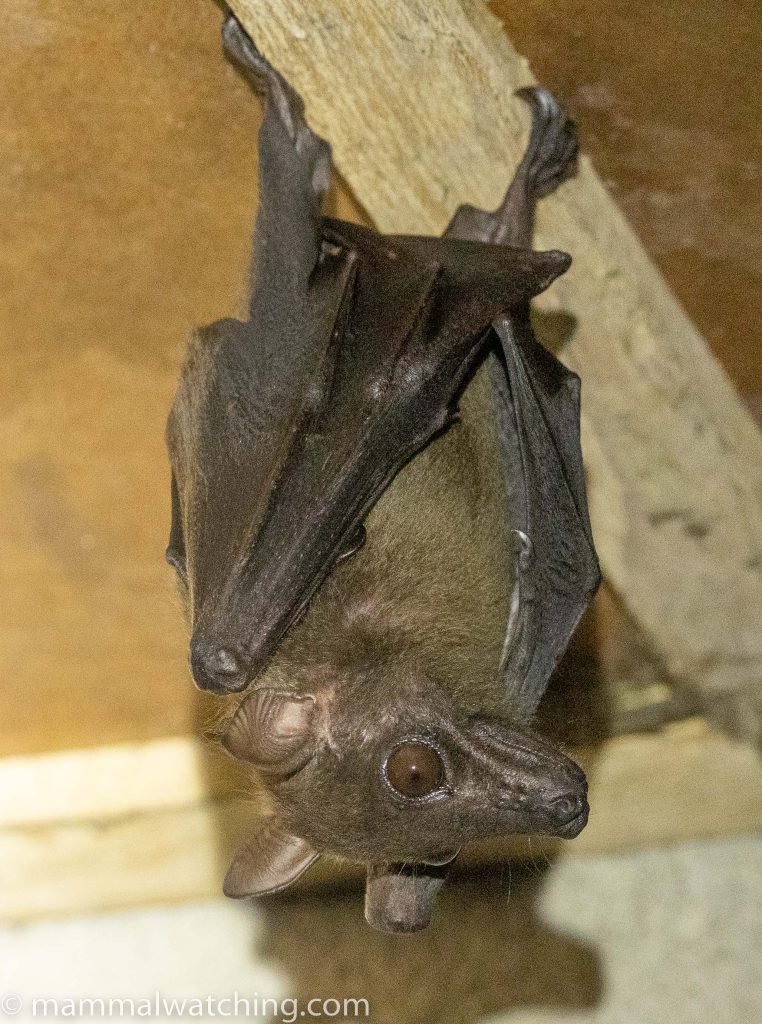
Angolan Fruit Bat (Myonycteris angolensis)
We were shown two roosts in abandoned buildings in Moka.
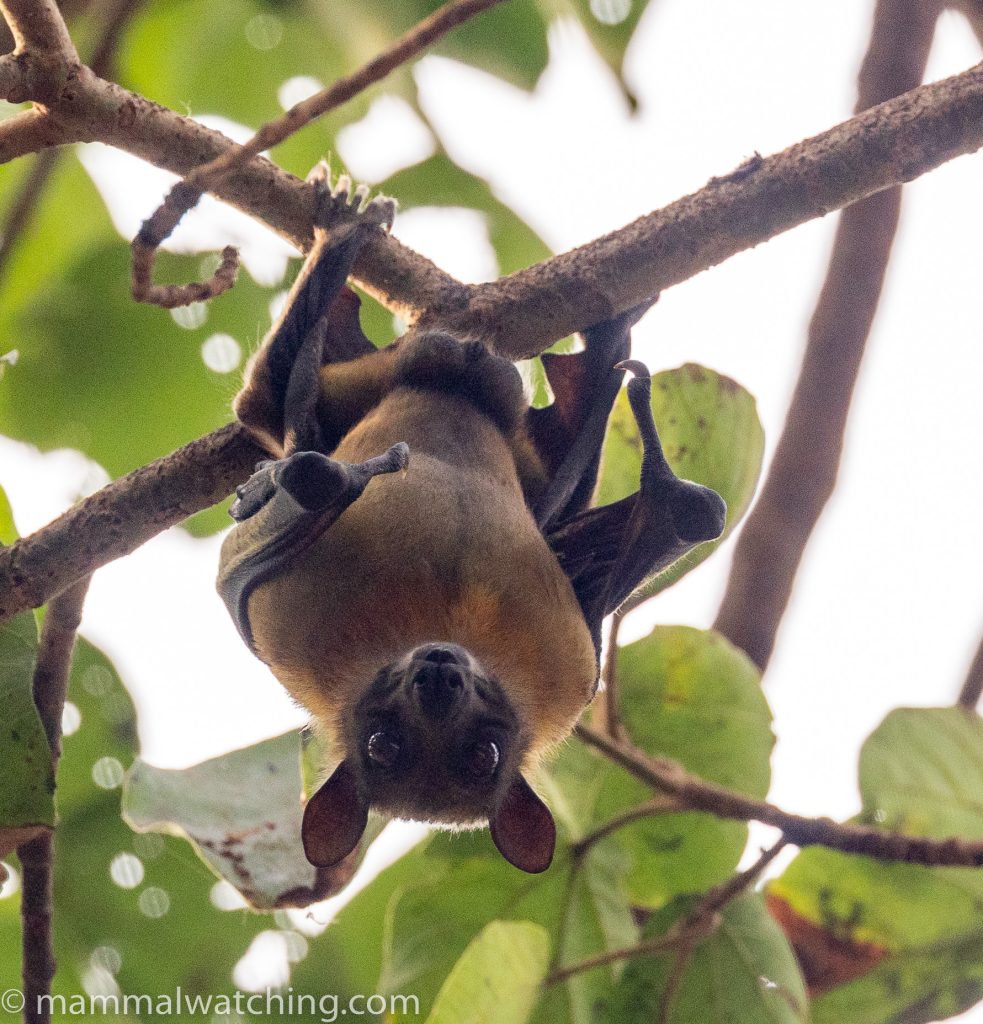
African Straw-coloured Fruit-bat (Eidolon helvum)
A colony were camping in trees in downtown Malabo. Our visit was cut short when our driver was summoned back to the hotel before someone called the cops (we were in danger or straying beyond the boundaries of our permit it seems).
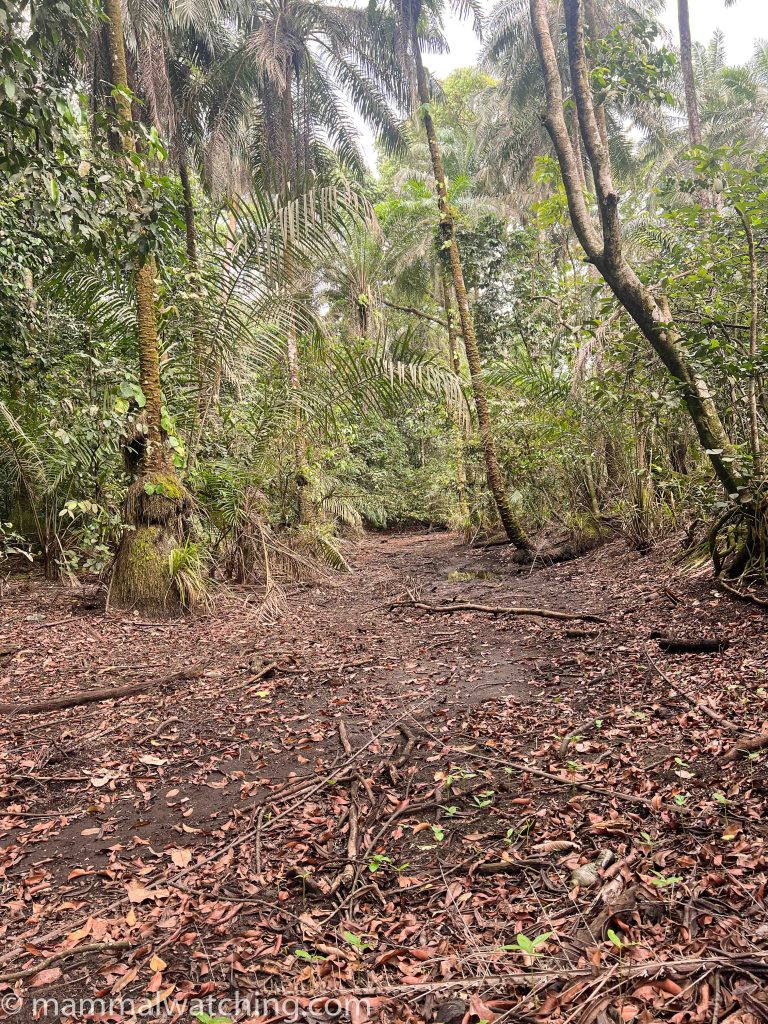
Blue Duiker (Philantomba monticola)
Despite the apparent hunting pressure around Moraka we saw several Blue Duikers, all after dark, very close to our campsite.
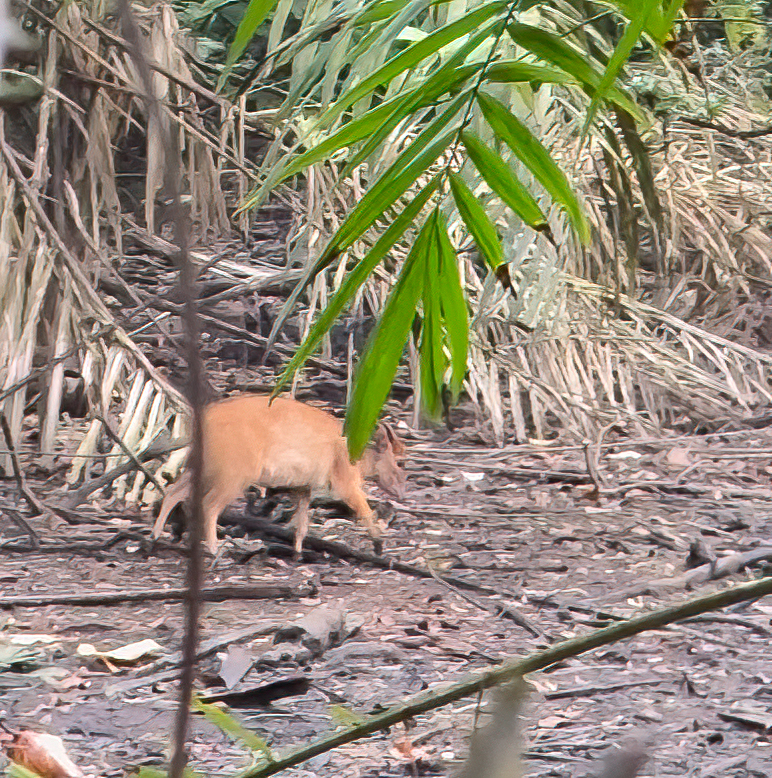
Ogilby’s Duiker (Cephalophus ogilbyi)
The local subspecies of Ogilby’s Duiker is more colourful than the crusalbum subspecies I had seen in Gabon. Nancy, Cheryl and I saw one or two Duikers near camp during the day. Probably easiest to observe by sitting quietly on the dry river bank and waiting. Nancy’s video – with a cellphone! – is here.
Mystery Mammal
Our last night night walk in Moraka produced a medium-sized arboreal mammal with very bright red eyeshine. It was high, distant and seemed to be avoiding the spotlight. I saw pieces of it fairly well through my bins and was convinced it was an African Palm Civet. Curtis later told me that there is no solid evidence that Palm Civets occur on Bioko. The next most plausible candidate would be needle-clawed galago, though it did not move like a galago at all. It was too large to be a Linsang. So – until someone discovers a Palm Civet on Bioko – this will remain a mystery.
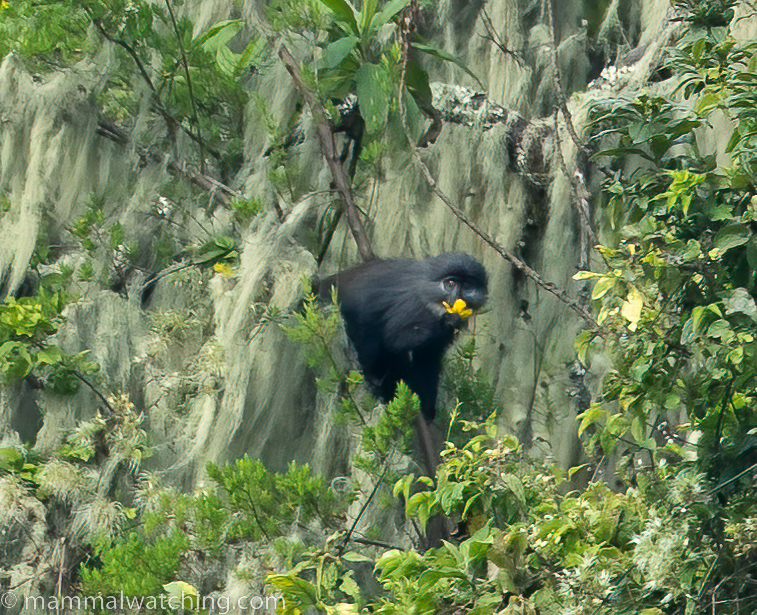
Stuff We – or some of us -Missed
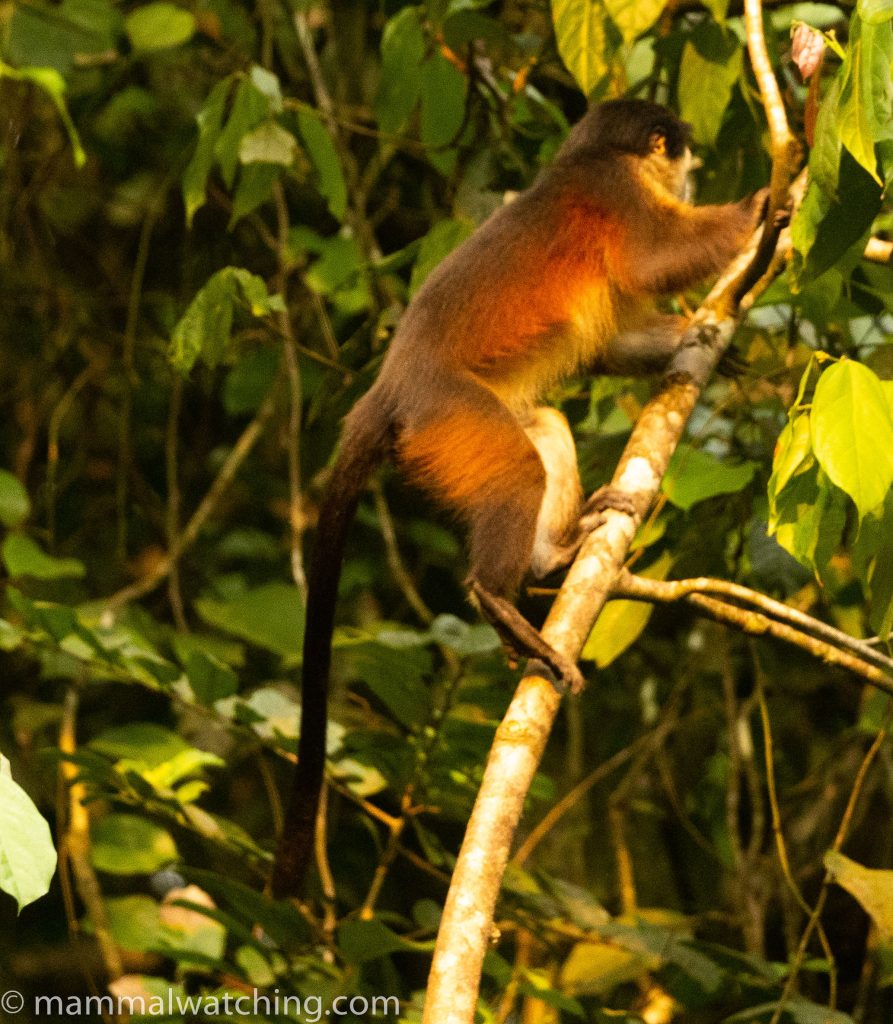
I set my mammal expectations using Curtis Hart’s report.
I was disappointed and surprised to miss Allen’s Squirrel Galago. These were common in Moka when Curtis was there. We thought we had seen one on our second night in Moka. I trusted the local guide’s ID and let down my guard. Fatal error. Had I known it was another Neede-clawed Galago I would have tried harder.
I was also surprised and disappointed not to see a Target Rat. Curtis’s report suggested they were very common at the camp in Moraka and I thought a thermal scope would have found one.
I was disappointed, but less surprised, to miss African Pygmy Squirrel, Brush-tailed Porcupine and African Linsang. Martin Royle saw a Pygmy Squirrel so they are still at Moraka and the local guides I spoke to all said African Linsangs were not uncommon at the three sites we visited. Porcupines were, they said, sometimes seen around Moraka too though are presumably a popular bushmeat.
I was neither surprised nor disappointed to miss Black Colobus at Moraka. The monkeys are still around but are not common and, as I had seen them very well in Gabon, they were not a priority. Our local guide heard some calling.
The chances of seeing a White-bellied Pangolin and Cameroon Scaly-tail were always slim to miniscule. No one seemed to know anything about the scaly-tail and I got the sense that pangolins were even rarer now then when Curtis was there. Hardly a surprise.
Final Thoughts
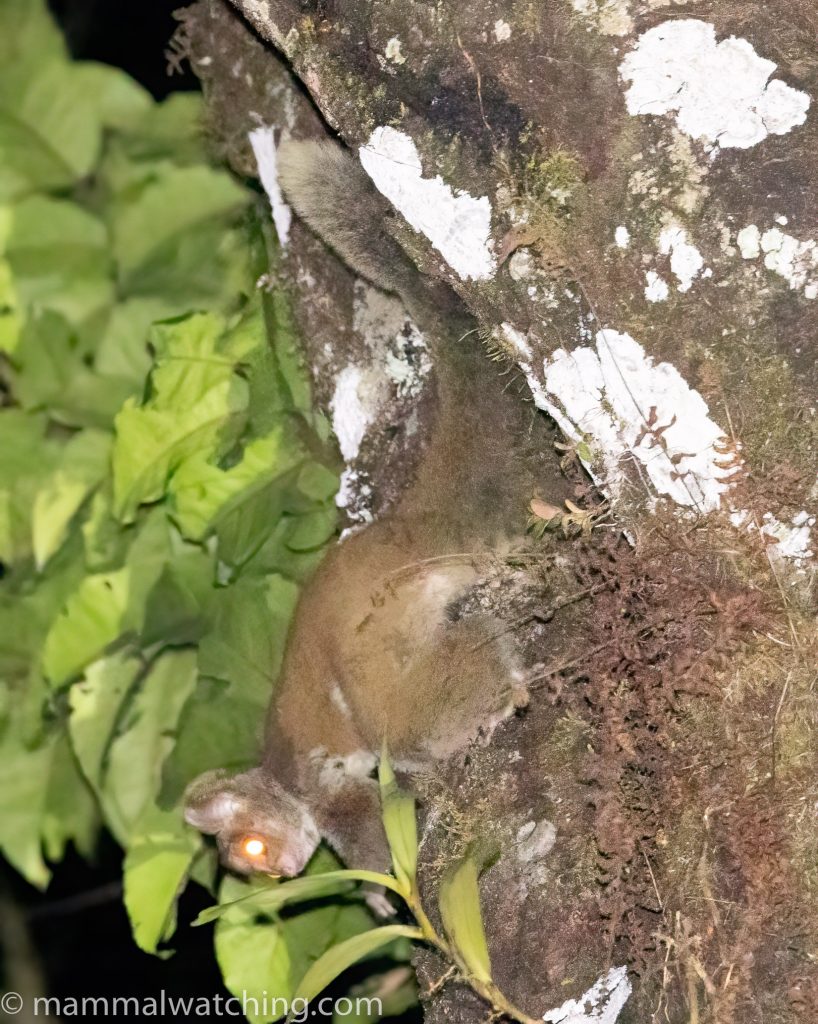
When mammalwatching becomes an Olympic competition I’d rate this trip: 8/10 (interesting), 5/10 (mammal list) and 3/10 (satisfactory views).
I was very glad to finally get the chance to visit Bioko. I had hoped to see one or two additional species – African Linsang I am talking about you! – but the trip was more productive than my they have hunted everything out worse case, post-COVID, scenario that was in the back of my mind. Diurnal primates are generally very wary but we had stellar looks at other species that can be very hard to observe including Western Tree Hyrax and Ogiby’s Duiker.
There is a great deal of forest left on Bioko which gives me hope. I would be more hopeful if there was more evidence that bushmeat hunting was being regulated. The country does, after all, have a high per capita income and so a non-endangered primate food source ought to be available to all.
A big thank you to Guillermo Casasnovas from Middle Africa for making this happen and remaining calm when I was convinced my visa wouldn’t arrive. This cannot be an easy place to run tours to, though everything went very smoothly thanks to Middle Africa’s talent in navigating the country. Middle Africa’s Jorge Fernandez Garces, our trip leader, was great company and extremely patient with our many and varied demands. Thank you too to Curtis and Lindsay Hart for the real time information updates (Video & Photo Report of the Search for Drills on Bioko Island in January 2023 – Mammal Watchingeven though they were mammalwatching in Colombia) and to him and Venkat for help with small mammal IDs on my return. And last but definitely least a big thanks to my fellow mammalwatchers: you were a pleasure to travel with.
Angiolo Laviziano made a great 11 minute video documenting this trip that you can see here.
Trip List
Western Tree Hyrax (Dendrohyrax dorsalis)
Beecroft’s Anomalure (Anomalurus beecrofti)
Lord Derby’s Anomalure (A.derbianus)
Isabelline Red-legged Sun Squirrel (Heliosciurus rufobrachium)
African Giant Squirrel (Protoxerus stangeri)
Red-cheeled Rope Squirrel (Funisciurus leucogenys)
Green Bush Squirrel (Paraxerus poensis)
Forest Giant Pouched Rat (Cricetomys emini)
Bioko Hybomys (Hybomys basilii) – endemic
Western Rainforest Thicket Rat (Grammomys poensis) (?)
Allen’s Hylomyscus (Hylomyscus alleni)
Cameroon Praomys (Praomys morio)
Northern Needle-clawed Galago (Euoticus pallidus)
Drill (Mandrillus leucophaeus)
Preuss’s Monkey (Allochrocebus preussi)
Red-eared Monkey (Cercopithecus erythrotis)
Crowned Monkey (C.pogonias)
Pennant’s Red Colobus (Piliocolobus pennantii) – endemic
Bioko Forest Shrew (Sylvisorex isabellae)
Angolan Fruit Bat (Myonycteris angolensis)
African Straw-coloured Fruit-bat (Eidolon helvum)
Blue Duiker (Philantomba monticola)
Ogilby’s Duiker (Cephalophus ogilbyi)
23 confirmed species including 9 lifers in bold.
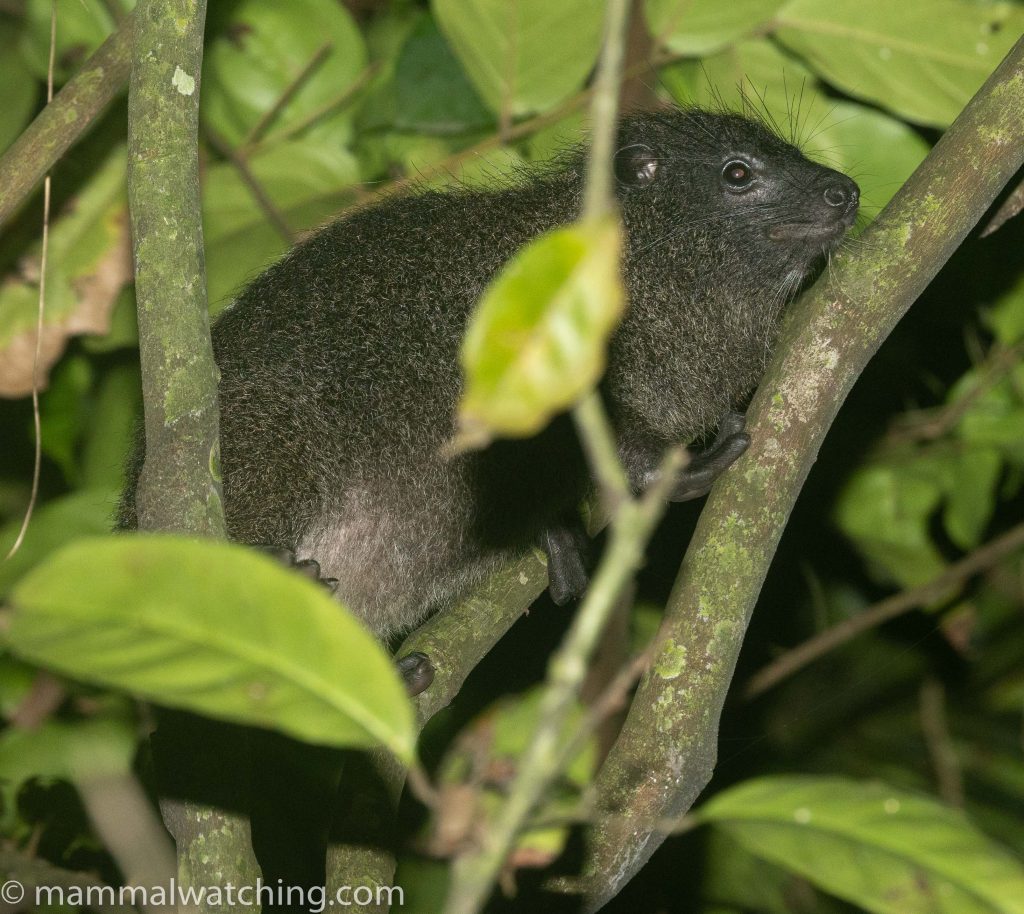


Leave a Reply
You must be logged in to post a comment.